
Sea Surgeon's Dispensatory: 1 2 3 4 5 6 7 8 9 10 11 12 13 14 15 16 17 18 19 20 21 22 23 24 25 Next>>
The Sea Surgeon's Dispensatory, Page 15
Simples: Plants
Furfur Tritici (Wheat Bran)
Listed in: Woodall: Furfur Tritici1
Category: Simple - Plant
Humoral Property: hot and moist in the second degree2; "hot in the first degree"3
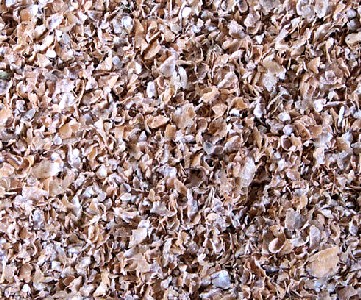
Photo: Wiki User Rasbak - Wheat Bran
Description: "Furfur or wheate branne, is good against the scurfe [flaking of the skin], itch, and spreading scab, dissolveth the beginning of hotte swellings, doth flake and swage [assuage?] the hard swellings of womens breast, and is singular good the decoction thereof to cure the painefull exulcerations in the internalls is given by glisters [clysters - enemas], as is mentioned in the cure of Disenteria [dysentery].”4
“Furfur, Bran. This being of a porous spongy Substance in the Composition of a Cataplasm [poultice], the Warmth of the Part it is apply’d to, so rarefies it, that being kept from external Air, all that can transpire will be suck’d up into its Interstices; by the same Reason or Mechanism, as the Flesh rises up into a Cupping-Glass. Things that are efficacious therefore in this manner, should be only apply’d where there is good probability of the Matter’s transpiriting; otherwise they will draw more to the Part, and thereby increase the Malady."5
1 John Woodall, the surgions mate, 1617, p. 118; 2 Theatrum of Canatese, Tacuinum sanitatis - Casanatense 418 on wikimedia commons, gathered 6/1/15; 3,4 Woodall, p. 118; 5 John Quincy, Pharmacopoeia Officinalis & Extemporanea, 1719, p. 216
Galbanum
Listed in: Woodall: Galbanum1
Category: Simple - Plant
Humoral Property: hot and dry2; "hot in the second degree"3
Photo: Andrew Massyn- Galbanum Blister Bush
Description: "Galbanum ...is good if it be full of drops pure like frankincense, fatt, not full of sticks, strong in smell, neither moiste nor dry in substance: it extracteth, discusseth [disperses], bringeth away the courses stopt [causes menstruation],
and the birth: takes away biles, hard kernels, and knots in the body: and helpeth the cough, short breathing, convulsions, and ruptures."4
"Galbanum is a Gum brought from some Parts of Syria, of a yellowish Hue. It is warm, emollient [softening], and resolving [removes], and is good in all Hysterical Affections [problems affecting the upper chest on the sides]; but it is chiefly used by Application upon Plasters to the Navel. It loosens the Belly, both inwardly and externally used. It is often met with amongst extemporaneous Prescriptions in present Practice [from the Latin 'ex tempore'("at the time") - a prescription written on the spot for a specific patient with a specific ailment], but is in very few Shop-Medicines [compound medicines made by apothecaries]; although in a small Quantity in Theiraca Andromachi, and Diascordium."5
1 John Woodall, the surgions mate, 1617, p. 105; 2 Nicholas Culpeper, Pharmacopœia Londinesis, 1720, p. 46; 3 Woodall, p. 105; 4 Woodall, p. 105-6; 5 John Quincy, Pharmacopoeia Officinalis & Extemporanea, 1719, p. 91
Gallæ (Oak Tree Galls)
Listed in: Woodall: Gallæ1
Category: Simple - Plant
Humoral Property: cold in the second, dry in the third degree2; "colde in the second degree, and dry in the third"3
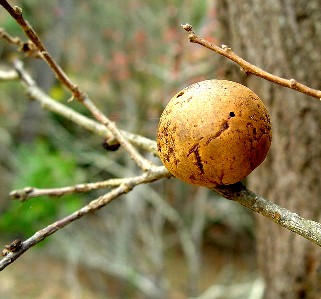
Photo: Franco Folini - Oak Tree Gall
Description: "Gallæ or Gales ...cureth fluxions of the gummes: helpeth the ulcerations of the mouth, stayeth the fluxes menstruall, and helpeth the mother falling downe [prolapsed uterus], maketh the hair blacke, and consumeth proud [unwanted growing] flesh in wounds and ulcers, and induceth a good healing to them."4
"Gallæ, Galls. These ...are in little else besides the Emplastrum ad Herniam. ...they make so necessary an Ingredient in Writing-Ink. They are accounted effectual in stopping Hemorhages, and therefore Ink is put up the Nose to stop bleeding."5
"Gauls are exceeding binding, help Ulcers in the mouth, wasting of the Gums, ease the pains of the teeth, help the falling out of the Womb [prolapsed uterus] and Fundament [prolapsed anus], make the hair black."6
“Another Sort also of Oak is the Robur... the Gall Oak. It grows in Pannonia [located near the borders of Hungary, Croatia and Serbia], and Isiria [Syria]. The Galls are used in Medicine. With respect to Galls, there are several sorts: The first and best is termed the Allepo Nut; or Galla Spinosa; the second is white; the third, smooth and Round; the fourth, of an irregular Figure; and the fifth has a kind of Crown. All these Galls are owing to Insects, which first prick the Oak Trees, and then lay their Eggs in the Wound: These Eggs swell with the Excrescence, and first turn to Worms; then to Flies, which having perforated the Galls, make their Escape. And as some Eggs are unfruitful, and remain in the Gall, they are observ’d to yield a volatile Salt. Galls are very astringent [contract the body's tissues], and are by some given inwardly in Dysenteries: They have also been recommended in Intermitting Fevers [most likely due to malaria]; but the Foundation of their Febrifigous [anti-fever] Quality, depends on too few Instances to be relied on."7
1 John Woodall, the surgions mate, 1617, p. 111; 2 Jean de Renou, A Medicinal Dispensatory, 1657, p. 392; 3,4 Woodall, p. 111; 5 John Quincy, Pharmacopoeia Officinalis & Extemporanea, 1719, p. 111; 6 Nicholas Culpeper, Pharmacopœia Londinesis, 1720, p. 42; 7 Robert James, Pharmacopoeia Universalis, 1747, p. 414-5
Gambogia
Listed in: Woodall-Chest: Cambodigiæ, or Guttigambe.1, Tweedy: Dulc. Gutt. Gamb.2
Category: Simple - Plant
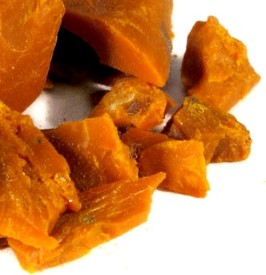
Gamboge Resin
Description: ""Gambogiæ, Gamboge; Cambogia Gutta, Lina, called also Gutta Gamba, comes from the Carcapuli of Parkinson, and the Bauphines; which grows in Malabar. This gum hath been longer known in painting than in medicine, for its yellow colour. The violence of its operation, both by vomit and stool, has occasioned abundance of search for some proper corrector; but none has yet been found better than the lixivious salts, and particularly salt of tartar"3.
"Cambodigiæ, or Guttigambe. Camobodigie is a purging medicine newly found out in the East Indies, and thence brought to us; it is not much unlike Stibium [antimony] in working, it is already in use by divers revered Phisitions... I find by my practise it purgeth well the head, and that it is good to open obstructions, and that it is good also against the yellow Jandice, and that it openeth well the spleene, and liver, and purgeth more downwards than Stibium doth, the dose is 12 graines"4.
1 John Woodall, the surgions mate, 1617, p. 96; 2 "158. John Tweedy's Bill for Medicines. November 8, 1743". Privateering and Piracy in the Colonial Period Illustrative Documents, John Franklin Jameson, ed., p. 459; 3 Woodall, p. 96; 4 John Quincy, Pharmacopoeia Officinalis & Extemporanea, 1719, p. 172
Glycyrrhiza (Licorice)
Listed in: Woodall: Liquiritia1, Moyle: Liquorisia2
Category: Simple - Plant
Humoral Property: hot3; hot and moist4; "temperate in all qualities, but ascedes nearer to calour [heat]"5
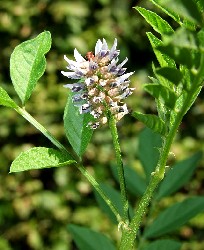
Photo: Pharaoh Han
Liquorice -
Glycyrrhiza Glabra
Inflorescence
Description: "Liquiritia ...agreeable to the lungs, and breast; rotteth phleame [phlegm - a bodily humor], moveth expectoration [removes mucus from the lungs], cureth the cough, helpeth breathing, and is profitable for the reines [kideys], taking away the sharpenesse of urine, dissolveth the [kidney] stone, and healeth the sores of the kidnies and bladder."6
"Liquorish, in Latin Glycyrrhiza. 'Tis good for the Lungs, and the Reins. It mitigates Acrimony, and helps Expectoration, and gently loosens Children's Bellies. 'Tis chiefly used for Coughs, Hoarsness, Consumption [tuberculosis], Pleurisie, Erosions of the Bladder, and Sharpness of Urine."7
"The whole plant is dominated from the sweetnesse of the root; for Glycyrrhiza, which Pharmacopolists call Liquorice, denotes a sweet root... retained in the mouth, it quenches thirst. ... In the Moneth of July or sooner, it beares Cods about the bignesse of Vetches or Cicers [chickpeas]. ... The Cappadocians and Spaniards bring us every yeare Liquorice-Juice, condensed into Pastills."8
Modern Uses: No study definitively supports the use of Licorice root. However, it may help relieve digestive symptoms, although this has not been effectively proven. Topical gels containing licorice root may help eczema. Gargling with something containing licorice may lessen the severity of a sore throat before surgery. Note that this is not medical advice and the author is not a medical professional. Licorice root can cause increased blood pressure and decreased potassium if consumed in large amounts. Heavy consumption is not safe by pregnant women.9
1 John Woodall, the surgions mate, 1617, p. 99; 2 John Moyle, The Sea Chirurgeon, 1693, p. 33; 3 Thomas Brugis, The Marrow of Physick, 1669, p. 145; 4 Nicholas Culpeper, Pharmacopœia Londinesis, 1720, p. 8; 5 Jean de Renou, A Medicinal Dispensatory, 1657, p. 304; 6 Woodall, p. 99; 7 John Pechey, The Compleat Herbal of Physical Plants, 1707, p. 143; 8 Renou, p. 304; 9 Stephen Foster, "Licorice Rootr", www.nccih.nih.gov, gathered 2/17/23
Guaiacum Officinale
Listed in: Woodall: Guaicum.1
Category: Simple - Plant
Humoral Property: hot (calefy)2; dries ["exiccate"]3
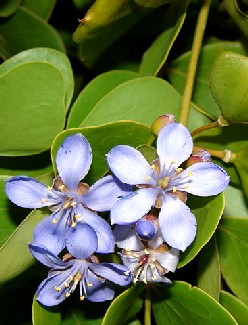
Photo: Forest & Kim Starr -Guaiacum Officinale
Description: "Lignum Guaicum doth exiccate [dry], attenuate [reduces the force of], open, purge, move sweate, resisteth contagion, and infection, and doth wonderfully cure the morbius Gallicus [syphilis], olde ulcers, scabs, and ring-worme, the best use thereof is by decoction in faire water [clean, pure water]."4
"Guajicum is so called by the Indians, from the German word Guajacum, by the Latins, Lignum sanctum; it is brought from the Western Islands Boriquen, Cuenga, Nagrande, and Nicaragua.
It is a tall tree, in magnitude and effiegies like an Illex, or Oak, ramous [branching], blackish in the middle, hard, with a crass [thick] and fat bark, small and hard leaves, luteous [light greenish-yellow] and purgative flowers, which the Indians condite [pickle] and assume [put on], to purge their bodies.
...
There is another sort of Guajacum which is lesser, but better, which they call Palus Christi, and sometimes Lignum sanctum; it is a shrub in colour, faculties, magnitude and form, much unlike the great Guajacum: for the matter of its wood is white, concolorate [having a uniform color], and very fibrous; its sapour [flavor] is sharper, odour mare fragrant, and qualities more efficacious. But because it is very rare, in want thereof we usurpe [substitute] Guajacum, which is endued with the same faculties, but more infirm.
Both of them are prevalent in curing the French disease [syphilis]; for they calefy [warm], incide [resolve or break up], attenuate [reduce the force of], open, move sudour [sweat], exarceate putretude [remove rottenness?], and by special properties extinguish venereous poyson."5
1 John Woodall, the surgions mate, 1617, p. 98; 2 Jean de Renou, A Medicinal Dispensatory, 1657, p. 288; 3,4 Woodall, p. 98; 5 Renou, p. 288
Gum Ammoniack
Listed in: Woodall: Amoniacum1
Category: Simple - Plant
Humoral Property: hot in the second degree and dry in the first2; hot & dry in the 3rd degree3; "hot in the third degree"4
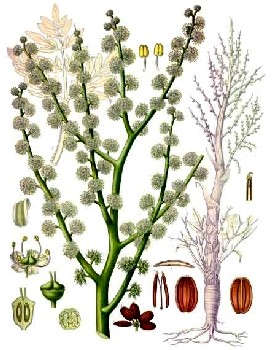
Artist: Franz Eugen Koehler
Dorema Ammoniacum, Source of Gum
Ammoniac (1897)
Description: "Amoniacum, a gumme so called ...hath the force of mollifying [softening] so effectuall, that it dissolveth Tophoes [tophi - deposits of uric acid crystals in the joints, cartilage, bones, and other places] or hard stones growne in the flesh: easily discusseth [disperse] other pustles: healeth the spleene hardned: and being given in drinke taketh away many obstructions: provoketh the monethly courses [menstruation], and urine: driveth out the [kidney] stone: dissolveth the Kings evill [scrofula, or struma, a tuberculous swelling of the lymph glands]; is very profitable for aches from cold: that which is pure thereof is like Thus [frankincense] formed and in smell, and in taste like Castortum [Castoreum - an exude from the castor sacs (located near the anus) of the mature North American Beaver]."5
"Ammoniaci, Gum Ammoniack. This is a Gum from a ferulaceous Plant [one having a stalk like a reed] growing in some parts of Asia. It has by some been call'd Hammoniacum, from its growing near the Temple of Jupiter Hammon. That is best which is freest from Dross, a yellowish Colour without, and white within, and of a bitterish Taste, and Castor Smell. It very much attenuates [reduces the force of] and deterges [cleanses], and is therefore properly used in all Distempers arising from Grumes [clots, such as blood clots] and Viscidities [thick, sticky substances], which stuff up the Vessels, and prevent particularly a due Motion of the nervous Fluids. For this reason it is found of mighty service not only in Asthma's and Infarctions of the Lungs, but in nervous Cases, and particularly those term'd Hysterical. The most convenient Form to prescribe it in, is in Pills."6
1 John Woodall, the surgions mate, 1617, p. 105; 2 Thomas Brugis, The Marrow of Physick, 1669, p. 162; 3 Nicholas Culpeper, Pharmacopœia Londinesis, 1720, p. 74;64,5 Woodall, p. 105; 6 John Quincy, Pharmacopoeia Officinalis & Extemporanea, 1719, p. 136
Gummi Guaici (Guaiacum Resin)
Listed in: Woodall: Gummi Guaici1
Category: Simple - Plant
Humoral Property: hot (calefy)2; dries [exiccate]3
Photo: Maša Sinreih - Guaiaci - Guaiacum Resin
Description: "Gummi Guaici, the gumme of the Guacum hath the same virtue as the wood and barke aforesaid, called Lignum Guiacum, and drunke in powder is approoved a good remedy in Gonorrhea."4
"Guaiaci, of Guiaiacum. This Gum, or rather Resin, is much of the same virtue as the Wood whence it is drawn, but more efficacious. It is reckon'd much to promote insensible Perspiration, and upon that account is good in such cutaneous Cases as proceed rom Obstructions of the perspirable Matter in the Milliary Glands [small glands thought to be underneath the surface of skin that excrete muscilage]. It is very warm and detersive [cleansing], and therefore good in all Ulcerations and Gleets [running fluids], both internal and external. In Gonorrhæa's it is by some almost deem'd a Specifick [medicine used particularly to treat that problem]. In the Gout likewise it does frequently great service, not only by deterging and cleansing the Joints and mucilaginous Glands from tartarous Matter, but by warming and strengthening the Fibres, enables them to move with that vigour, as shakes off and prevents the Lodgment of such Particles upon them."5
1 John Woodall, the surgions mate, 1617, p. 104; 2 Jean de Renou, A Medicinal Dispensatory, 1657, p. 288; 3 Woodall, p. 98; 6,7 Woodall, p. 104; 8 John Quincy, Pharmacopoeia Officinalis & Extemporanea, 1719, p. 166
Gummi Tragacantha
Listed in: Woodall:Tragacanthum1, Tweedy:Gum Tragacanth2
Category: Simple - Plant
Humoral Property: hot and moist in the first degree3; "a temperate hot gumme"4

Artist: David Blair
Astralagus Gummifer, Source of
Gummi Tragacanth, From Medicinal
Plants by Robert Bentley and Henry
Trimen, p. 73 (1880)
Description: "Tragacanthum ...is good for the cough, roughnesse of the Artery or wind-pipe, hoarsnesse and defluxions [discharges], being taken with honey, or with sugar, and is commended to be good for the eyes, also it is good to be swallowed downe whole, or eaten in powder against the flixe [flux - diarrhea]."5
"Tragacanthum, Commonly called Gum Trajacanth and Gum Dragon, helps Coughs, Hoarsness and Distillations upon the Lungs."6
"Gummi Tragacantha, Gum Tragacanth, or Gum Dragon, is a Gum which bursts forth from the Tragacantha, Offic. ...It is brought to us from Turkey in Pieces of different Sizes. Externally used it is of Efficacy in the Dysentery; and dissolved in Milk or Rose-water, is good for the Redness, and acrimonious Rheums [running fluids] affecting the Eyes, and for Asperities of the Eye-lids. Dissolv'd in Water, its Mucilage is very convenient for the Formation of Troches [lozenges], and other Forms of Medicines. It is moistening, lenient [softening], emplastic [adhesive], corrects Acrimony [corrosive humors], and incrassates [swellings], Hence it is of Efficacy in Hoarsenesses, Spitting of Blood, Asperities of the Fauces [the arched opening at the back of the mouth], and the Strangury [frequent, painful urination]; four or six Grains of it exhibited in Milk or Water, are effectual in voiding of Blood by Urine."7
1 John Woodall, the surgions mate, 1617, p. 107; 2 "158. John Tweedy's Bill for Medicines. November 8, 1743". Privateering and Piracy in the Colonial Period Illustrative Documents, John Franklin Jameson, ed., p. 459; 3 Thomas Brugis, The Marrow of Physick, 1669, p. 163 ['much the same as Arabic']; 4,5 Woodall, p. 107; 6 Nicholas Culpeper, Pharmacopœia Londinesis, 1720, p. 45-6;7 Robert James, Pharmacopoeia Universalis, 1747, p. 334
Hordeum (Barley)
Listed in: Woodall: Hordeum1
Category: Simple - Plant
Humoral Property: cools [refrigerates] and dries [exsiccates]2; "cold and drie in the first degree"3
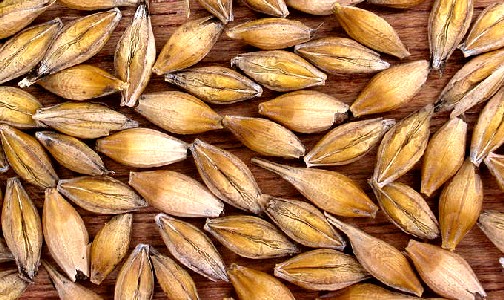
Photo: Wiki User Rasbak - Barley Seeds
Description: "Hordeum commune (in English is said to be barley) ... digesteth [causes new flesh to grow], softeneth, and ripeneth all hard swellings, is good for inflammations, excelleth against the soarenesse of the throate, refrigerateth [cools], comforteth, strengthneth, is abstersed [cleansing/purgative], and provoketh urine."4
"Hordeum, Offic.... It is sow'd in the Spring in Fields. The Seed is used, which is refrigerating, drying, abstergent, aperient [laxative], digestive, and emollient [softening]; it is also diuretic and nutritive."5
1 John Woodall, the surgions mate, 1617, p. 99; 2 Jean de Renou, A Medicinal Dispensatory, 1657, p. 366; 3,4 Woodall, p. 99; 8 John Quincy, Pharmacopoeia Officinalis & Extemporanea, 1719, p. 127; 6 John Pechey, The Compleat Herbal of Physical Plants, 1707, p. 202; 5 James Rennie, A New Supplement to the Pharmacopœpias of London, Edinburgh, Dublin and Paris, Baldwin and Cradock, 1833, p. 263; 6 Robert James, Pharmacopoeia Universalis, 1747, p. 342;
Hordeum Gallicum (French Barley)
Listed in: Woodall: Hordeum Gallicum1
Category: Simple - Plant
Humoral Property: cooling2; "cold and drie in the first degree"3
Photo: T. Voekler - Lady Bug on Barley
Description: "Hordeum Gallicum more used inwardly then the Hordeum comune [common barley] by the Phisitions in medicaments, is of the same nature and vertue as the other is."4
"Hordeum Distichon; also called Hordeum Gallicum; common barley is freed from the husks or shells in mills, and in this state is called French or Scotch Barley. The [Royal] college [of Physicians] have retained this seed in their Pharmacopeia."5
"Hordeum mundatum & perlatum, Offic. French, or Pearl Barley. What we call French Barley, because it is usually imported from France, is nothing but Barley decorticated [removed from its shell] in a Mill, adapted to that Purpose. What we call Pearl Barley, because it resembles Scots Pearls, is prepar’d after the same Manner; only is twice or thrice subjected to the Mill, in Order to be ground, and made less. Both of them agree in Virtues with common Barley, only are more nutritive.”5
1 John Woodall, the surgions mate, 1617, p. 99;5 Nicholas Culpeper, Pharmacopœia Londinesis, 1720, p. 44; 3,4 Woodall, p. 99; 5 T. and J. Swords, The American Medical Lexicon, 1811, not paginated; 6 Robert James, Pharmacopoeia Universalis, 1747, p. 479-80
Hyssopi (Hyssop)
Listed in: Tweedy: Hyssop1
Category: Simple - Plant
Photo: H. Zell - Hyssop (Hyssopus Officinalus)
Humoral Property: hot and dry in the 3rd degree2; hot & dry in the 3rd degree3
Description: "Hyssop... attenuates [reduces the force of something], its chief use is in tartarous diseases of the lungs, cough, asthma; some prefer it in strengthning the stomach before Wormwood [absinthii]"4
"Hyssopi, Hyssop. This flowers in July and August. It is warm and detergent [cleansing/purging], and therefore good in many kinds of Coughs and Disorders of the Lungs and Breast, which arise from Phlegm [a bodily humor] and viscid Humours. It is good in Asthma's, promotes Expectoration [coughing up mucus from the lungs], and gives relief in Difficulty of Breathing. It is almost a constant Ingredient in Pectoral Apozems [compound medicines for treating the chest]. ...This is one of those very few Simples, of which there is a distill'd Water in the [Apothecary] Shops, that is good for anything."5
1 "158. John Tweedy's Bill for Medicines. November 8, 1743". Privateering and Piracy in the Colonial Period Illustrative Documents, John Franklin Jameson, ed., p. 459; 2 Thomas Brugis, The Marrow of Physick, 1669, p. 150; 3 Jean de Renou, A Medicinal Dispensatory, 1657, p. 329; 4 Brugis, p. 150; 5 Robert James, Pharmacopoeia Universalis, 1747, p. 131
Ladanum (Gum of Cistus Ladanifera)
Listed in: Woodall: Ladanum1
Category: Simple - Plant
Humoral Property: hot [calefactive]2; heating3; "hot and dry in the second degree"4
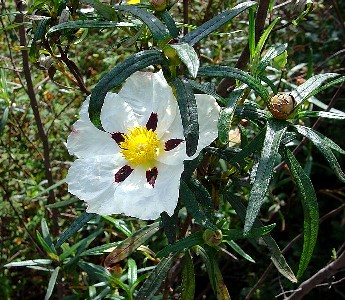
Photo: Francisco Santos - Cistus Ladanifer, Source of Ladanum
Description: "Ladanum ...doth calefie [warm], and mollife [soften]: open the pores of the veynes; keepeth the haire from falling of the head; stoppeth the laske [looseness of the bowels]; provokes urine: it is used seldom in the Surgeons Chest, except in making a greatefull odour, as when a fume of Cinabrium is to be prepared, for the cure of the pox [syphilis]."5
"Labdanum, is of a heating mollifying nature, it opens the mouth of the veins, stays the hair from falling off, helps pains in the Ears, and hardness of the Womb. It is used only outwardly in Plaisters."6
"Ladaum. This is a Gum ousing out of the Cistus Ladanifera.... This Gum mollifies, digests [breaks down], maturates [causes pus to form], and attenuates [reduces the force of things], and externally used is Anodyne [pain relieving], and good for the Tooth-ach. Alopecia [hair loss], Heart-burn, Pains of the Stomach, and hysteric Fits. In Dioscorides's Time, this Gum was gathered from the Hairs of the Goats, which fed among the Trees which produce it, but at present, according to Tournefort, the Greek Monks gather it from the Cistus Landaifera, with a Sort of Rakes. It is an excellent Balasmic in Dystenteries and Hoarseness."7
1 John Woodall, the surgions mate, 1617, p. 106; 2 Jean de Renou, A Medicinal Dispensatory, 1657, p. 391; 3 Nicholas Culpeper, Pharmacopœia Londinesis, 1720, p. 45; 4,5 Woodall, p. 106; 6 Culpeper, p. 45; 8 John Quincy, Pharmacopoeia Officinalis & Extemporanea, 1719, p. 127;7 Robert James, Pharmacopoeia Universalis, 1747, p. 352
Lupuli (Hops)
Listed in: Woodall: Lupines1
Category: Simple - Plant
Humoral Property: cool and dry in the first degree2; cools [refrigerates] moderately3; "hot and drie in the second degree"4
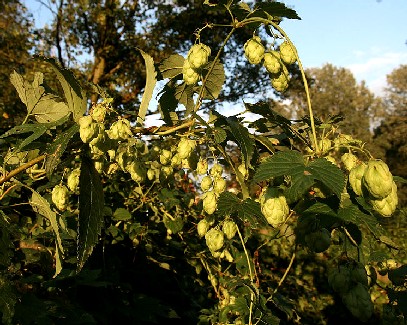
Photo: Manfred Werner - Hops (Humulus Lupulus)
Description: "Lupines ...digest [break down], make subtill and cleanse, kill wormes, drive away the speckles and spots like lentils in the face, asswage impostumations [abcesses] and swellings, the sciatica paine, digest, consume and dissolve Morbum Regium [tuberculosis]: Ripen and open wens [sties], botches, biles and pestilentiall sores."5
"Lupuli, Hops. These are used in medicine as the Chiches [chickpeas], in all like Intentions; but are hardly ever met with in common Prescription, unless their Flower be sometimes order'd in suppurating Cataplasms. That part of the Plant which is such a mighty Commodity in England, and used in our Malt Liquors under the Name of Hops, is reckon'd very discutient [matter dispersing], aperitive [opening], and good in all Obstructions of the Viscera [internal organs], and particularly of the Liver and Kidneys. ...They are likewise of an agreeable Bitter, and are upon that account good to strengthen the Stomach, and render those Liquors [liquids] much more grateful thereto, in which they are brew'd."6
1 John Woodall, the surgions mate, 1617, p. 109; 2 Thomas Brugis, The Marrow of Physick, 1669, p. 161; 3 Jean de Renou, A Medicinal Dispensatory, 1657, p. 359; 4,5 Woodall, p. 109; 6 John Quincy, Pharmacopoeia Officinalis & Extemporanea, 1719, p. 117;
Macis (Mace - Nutmeg Hull)
Listed in: Woodall: Macis1
Category: Simple - Plant
Humoral Property: heating and drying2; "hot and dry in the second degree"3,
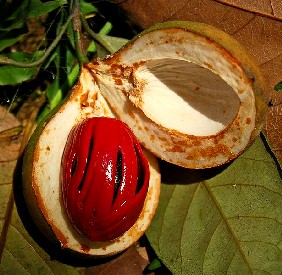
Photo: W.A. Djatmiko - Nutmeg and Hull
Description: "Macis, or Mace is ...strengthneth the stomacke: helpeth concoction [effective combination of the humors in the body]: discusseth winde: and comforteth the heart."4
"Mace, in Latin, Macis, 'tis the Covering of the Nutmeg, and is very Aromatick, and full of much Spirituous Heat, and is therefore good for cold Diseases, 'Tis much of the same Virtue with the Nutmeg; but because its Parts are finer, it works more powerfully, and is more penetrative."5
"Nux Moschata... The Nutmeg-Tree. It grows spontaneously in the Island of Banda [Indonesia], in the East-Indies, in great Plenty. ...The Fruit is about the Size of a small Peach, cover'd with a soft juicy Hull like a Walnut; immediately under this is found the Mace, which closely adheres to the subjacent hard, woody Shell, which incloses the Nutmeg. Nutmegs are heating, drying, and somewhat astringent [contract the body's tissues], stomachic [help with stomach problems], cephalic [good for treating problems of the head], and uterine; they discuss [disperse] Flatulencies, help Digestion, mend a fetid Breath, are reviving to the Fœtus in the Womb, are excellent in Faintings, and Palpitations of the Heart, diminish a tumid [swollen] Spleen, restrain Diarrhæas and Dysenteries, and stop Vomitings. The Fruit is brought to us preserv'd from India; but these are eaten to Excess, are said to have a narcotic Quality, and to produce a Delirium, or Sort of Intoxication."6
1 John Woodall, the surgions mate, 1617, p. 103; 2 Robert James, Pharmacopoeia Universalis, 1747, p. 383; ,3,4 Woodall, p. 103; 5 John Pechey, The Compleat Herbal of Physical Plants, 1707, p. 301; 5 James Rennie, A New Supplement to the Pharmacopœpias of London, Edinburgh, Dublin and Paris, Baldwin and Cradock, 1833, p. 263; 6 James, p. 382-3
Manna
Listed in:Moyle: Manna1
Category: Simple - Plant
Humoral Property: moderately hot2
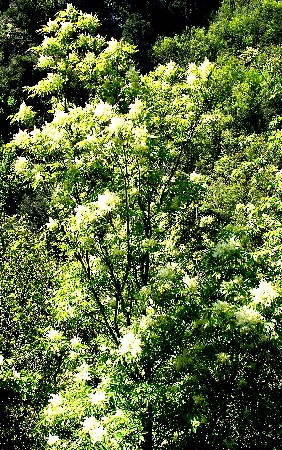
Photo: Jean-Pol_Grandmont
Manna Ash (Fraxinus Ornus)
Description: Manna is a juice which was found in the shops. "Experience has taught us that it is a safe and gentle Purge. It is as sweet as Sugar, and, like it, dissolves in any warm Liquor [liquid]. It is given to Children, from two Drams to an Ounce, and to grown Persons from one Ounce to two, or upwards. It is reckon'd only to deterge the Primæ Viæ [the bowels], and carry its Influence no farther than the Stomach and Bowels."3
There is confusion over where manna actually comes from French physician Jean de Renou identifies five different kinds of manna, four of which he says are not as good. (Manna Thuris, Manna Largina, Manna Eriansonnensis and Manna Mastichina - all of which come from trees in one way or another.4) His preferred form of manna is a type collected in Calbria, Italy, which is "celstial dew, sweet and gratefull, delabing [falling down] about the day-spring [dawn] upon the boughs and leaves of trees and herbs, which speedily concretes into the consistency of a gum."5
The more practical apothecary John Quincy mentions Renou's favorite celestial dew idea, but dismisses it, explaining manna is more likely the "Exudation from the Juice of some Plant, which had join'd with it some saline Particles in the Air, until it arrives to that form we see it in."6 Quincy does note that the best manna "comes from Calabria in Italy, and is white, in large Flakes"7.
Writing almost 30 years later (and over 20 years after the end of the golden age of piracy), physician Robert James simply notes that it "is certainly a Juice from the Trunk and larger Branches" of a Fraxinus or ash tree, known today Fraxinus ornus or the manna ash.8 "This Juice is every Year collected in hot and dry Weather, about, or a little before the Dog Days, and the August Rains, because, when rainy Weather begins, it ceases to flow"9.
1 John Moyle, The Sea Chirurgeon, 1693, p. 33; 2 Jean de Renou, A Medicinal Dispensatory, 1657, p. 227; 3 John Quincy, Pharmacopoeia Officinalis & Extemporanea, 1719, p. 184; 4, Renou, p. 226-7; 5 Renou, p. 226; 6,7 John Quincy, Pharmacopoeia Officinalis & Extemporanea, 1719, p. 184; 8,9 Robert James, Pharmacopoeia Universalis, 1747, p. 365
Mastic
Listed in: Woodall-Chest: Mastiche.1, Moyle: Mastich (Pulvis)2
Category: Simple - Plant
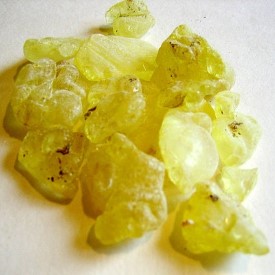
Photo (Wiki) Gixie - Mastic Tears or Arabic Gum
Humoral Property: hot in the second degree3; hot and dry in the second degree4; hot and dry in the third degree5
Description:"This is a resinous Gum of the Lentisch-Tree. It grows chiefly in the Island of Chios, and that Gum is most esteem which comes from thence. It is in small Granula, and white, if good; tho Age makes it turn yellowish."6
"Masticke sweet in smell, white, splendent, britle, old, and very dry, brought from the Isle Chio ...helpeth concoction [digestion]: stoppeth vomiting: confirmeth the power of reteyning sustenance, is abstersive [cleansing]: profitable also to them that spit bloud, or that are troubled with a cough: it attracteth fleame [phlegm - a bodily humor] from the braine; and is good for the breath."7
1 John Woodall, the surgions mate, 1617, p. 106; 2 John Moyle, The Sea Chirurgeon, 1693, p. 32; 3 John Quincy, Pharmacopoeia Officinalis & Extemporanea, 1719, p. 136; 4 Thomas Brugis, The Marrow of Physick, 1669, p. 164; 5 Nicholas Culpeper, Pharmacopœia Londinesis, 1720, p. 32; 6 Woodall, p. 120;7 Quincy, pp. 136-7
Melissa (Lemon Balm)
Listed in: Woodall: Melissa1
Category: Simple - Plant
Humoral Property: hot and dry2; hot [califies] in the second degree, dries [siccates] in the first3; "hot in the second, and drie in the first degree"4
Photo: Betty Cai - Melissa (Lemon Balm) in June
Description: "Melissa or Balme, this herbe ...doth bring downe womens termes [menstruation], helpeth against venome of Scorpions, spider, and Dogges, comforteth the head, increaseth the memorie, and refresheth the vitall faculties."5
“Melissa... or Balm. It is cultivated in Gardens, flowering in June. This Plant is endowed with extraordinary Virtues; for Pleasantness of Taste and Smell, no Herb exceeds it. The Leaves infused in Wine impregnate the same with its grateful Scent, and render it an highly useful and comfortable Medicine in all melancholy Affections; for it greatly exhilarates, being very cordial [good for the heart]. The expressed Juice has, also, an Astringence [ability to contract tissue], and is good for those who are subject to Melancholy, and hypochondriacal [upper part of the abdomen on either side] Flatulencies; and, in such Cases, it is always proper to be exhibited, though attendant on hot Disorders. ...The Herb is an excellent Remedy for hysteric Women, since it wonderfully exhilarates the Spirits. Women subject to rumblings of the Intestines, Eructations [belching], and Syncopes [faintings], are greatly relieved by Baum Leaves, bruised and held to the Nose, in the Paroxysms of these Disorders. …It is commended against Epilepsies, Madness, Barenness, Apoplexies [unconsciousness], Palsies, Vertigos, and Faintness. It is beneficial in Crudities of the Stomach, Obstructions of the Menses, and a Retention of the Lochia [vaginal discharge after birth]. It removes the fetid Smell of the Breath, and is serveable to those who labour under a Retention of Urine. Externally, it is used in Cataplasms, Baths for the Feet, poisonous Stings, and other Misfortunes of a like Nature."6
1 John Woodall, the surgions mate, 1617, p. 120; 2 Nicholas Culpeper, Pharmacopœia Londinesis, 1720, p. 32; 3 Jean de Renou, A Medicinal Dispensatory, 1657, p. 318; 4,5 Woodall, p. 120; 6 Robert James, Pharmacopoeia Universalis, 1747, p. 360
Menthæ (Mint)
Listed in: Woodall: Menthæ1
Category: Simple - Plant
Humoral Property: hot and dry in the 3rd degree2; hot & dry in the 3rd degree3; "of a hot nature"4; "hot and drie"5
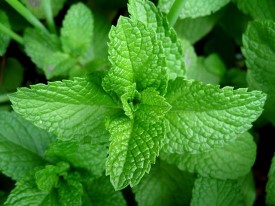
Photo: Kham Tran - Mint (Mentha)
Description: "Menthæ Mints ...doth profit the stomake, appease the hickok [hiccups], stoppeth vomiting, cureth chollericke [angry] passions, griping paine of the belly, and the inordinate course of menstrual issue; easeth women in their travell of childe-bearing, it softneth breasts swolne with milke, and keepeth the milke from crudding therein."6
"Menthæ, Mint. This flowers in July. It is much used in Medicine, as well as in Sallets [salads] and Sauces. It is justly esteemed a great Strengthner of the Stomach, and is of great service in taking off Nauseousness and Reachings to vomit, as also in stopping Fluxes of the Belly [diarrhea]. Its fragrant Scent makes it enter into many Compositions as a Cephalick [medicine for curing problems with the head]. There are many Medicines made of it in the [Apothecary] Shops; but the Spirit, the distill'd Water, and the Syrup, which is a Compound, are the principal."7
1 John Woodall, the surgions mate, 1617, p. 119; 2 Thomas Brugis, The Marrow of Physick, 1669, p. 151; 3 Nicholas Culpeper, Pharmacopœia Londinesis, 1720, p. 32; 4 Jean de Renou, A Medicinal Dispensatory, 1657, p. 315; 5,6 Woodall, p. 119; 7 John Quincy, Pharmacopoeia Officinalis & Extemporanea, 1719, p. 98
Millilotus (Melilot)
Listed in: Woodall: Millilotus1
Category: Simple - Plant
Humoral Property: hot in the first degree2; "indifferent as to either refrigeration [cold] or calefaction [hot]"3; "hot"4
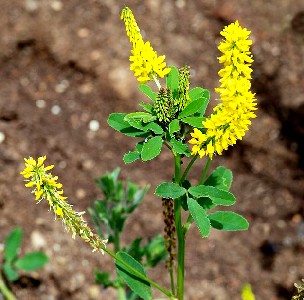
Photo: Wiki User Alvegaspar - Melilot (Melilotus Officinalus)
Description: "Millilotus Mellilote is ...astringent, it doth swage [assuage], and mollife hot swellings of the eyes, matrix [womb], fundament [anus], and genitories [genitals], healeth the scurfe [flaking of the skin], and putrified ulcers, dissolveth Apostumes [abcesses] of the stomake, is good for the head-ach, provoketh urine, breaketh the [kidney] stone, helpeth the paine of the kidnies, bladder, and belly, and taketh away the webbe and pearle of the eye [cateract]."5
"Melilotus, Melilot. ...It is the principal Ingredient in the Plaster, which has its name from it in the [apothecary] Shops, so much in use. It consists of warm subtile Parts, as is manifest by the very Scent of the Plant, and upon that foot comes under the Head of Ripeners. It is mostly employ'd in dressing Blisters until they cease running, and skin over: for its Warmth still promotes the Discharge, and prevents Mortification, which in some Constitutions they are very liable to; especially if dress'd with things that are cooling, which the Heat of the Part frequently provokes Persons very injudiciously to do."6
"It flowers in June and July, and grows amongst Bushes and sometimes with Corn."7
1 John Woodall, the surgions mate, 1617, p. 119; 2 Thomas Brugis, The Marrow of Physick, 1669, p. 151; 3 Jean de Renou, A Medicinal Dispensatory, 1657, p. 364; 4,5 Woodall, p. 119; 6 John Quincy, Pharmacopoeia Officinalis & Extemporanea, 1719, p. 217; 7 John Pechey, The Compleat Herbal of Physical Plants, 1707, p. 153-4
Myrobalans
Listed in: Woodall: Mirabolanes1, Moyle: Mirabolans2, Chebs.3 (Moyle lists chebulic myrobalans separately for the generic category some reason)
Category: Simple - Plant
Humoral Property: cold and dry3
Photo: Wiki User Vinayaraj - Myrobalan Terminalia bellerica
Description: "Mirabolani (whereof there are five kindes, the Citrine, Indian, Bellericke, Chebule, and Emblicke) have peculiar vertues, some purge choler [yellow bile - one of the bodily humors], others melancholie [black bile - another bodily humor], others phleame [phlegm - yet another humor], but as they purge so they binde againe, comforting and strengthening the heart, stomacke, and liver, and therefore are fit purgers of the body in dissenterie [dysentery] upon any occasion, there dose is {2 drams}."4
"Myrobalani, Myrobalans. These are a kind of dry foreign Plumbs. They were not known to the Greek Physicians, but are much in the Arabian Pharmacy. Sennertus [German physician Daniel Sennert] much used them, and frequently in Diarrhæs and Dysenteries, for some Astringency [ability to contract tissues] which attended their puragative Quality. They are in some officinal Compositions [compound medicines found in the pharmacopeas], but not regarded in common Prescription."5
Although the Sea Surgeon's Pharmacopoeia relies primarily
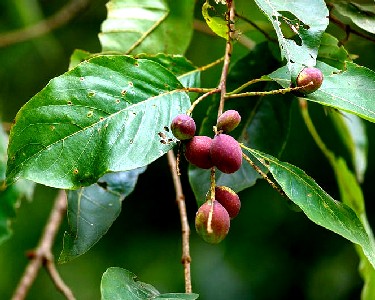
Photo: Zhang Zhugang - Myrobalan Terminalia chebula
on descriptions from period sources, myrobalans are one of the medicinals that were described in a very confusing way during the golden age of piracy. It appears that while most sources consistently identify five types of myrobalans in use at this time, there were actually only three or possibly four of them.
French physician Jean de Renou hints at the problem, explaining that "The nomenclature then is more received by use and custome, than by reason and nature."6 However, his point isn't that some of them were the same fruit, but that "the diversity of their forms and faculties demonstrates the errours of such, who contend that they grow upon one and the same tree, but are severally at divers seasons collected."7 While Renou is indeed correct that the different types do grow on different trees, he e doesn't recognize any problem with the number of types of myrobalans.
Renou goes on to list all five of the fruits. The names he gives are somewhat different than those Woodall's, noting that their "names Garcias [Portuguese herbalist and physician Garcia de Orta] hath got from the Inhabitants [of the Kingdom of Cambala [probably near modern Beijiing in southeast China], and hath delineated the several trees and fruits in a few words."8 The five myrobalans he lists include:

Photo: J. M. Garg - Myrobalan Terminala arjuna
Arare ...or the flave [yellow] Myrobalamb, is round, and bears leaves like Sorbus [This appears to be the Phyllanthus emblica, Woodall's 'Emblicke' and possibly 'Citrine' myrobalans. The citrine myrobalan is mentioned and not well described in several period texts.9 'Citrine' means "A light to moderate olive."10 This coloring could suggest that the citrine myrobalan is either Phyllanthus emblica or Terminalia bellerica.]
Rezanuale, or the Indian black Myrobalamb, is eight squared, and hath leaves like a Willow. [This may be the Terminalia arajuna, Woodall's 'Indian' myrobalan, based on the color, although the leaves sound more like those of Phyllanthus emblica. Writing in 1903, Sir Henry Yule and Arthur Coke Burnell said, "The Black Myrobalan, otherwise called 'Indian' and the Yellow or Citrine. These according to [John Forbes] Royle (Essay on Antiq. of Hindoo Medicine, pp. 36-37), were both products of T. Chebula in different states; but this does not seem quite certain."11 Based on this logic, there would only be three types of myrobalans mentioned in period texts: Terminalia chebula, Terminalia Bellerica and Phyllanthus emblica. Although Royle lumps the 'Citrine', 'Indian' and 'Yellow' myrobalans in with the Chebula, their names and description sound more like Phyllanthus emblica.]
Gotim, of Bellirian, hath leaves like Bay, but more cineritious [coloring like ashes] and pale. [This appears to be the Terminalia bellerica, Woodall's 'Bellericke' myrobalan.]
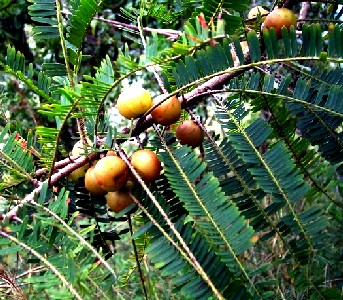
Photo: L. Shyamal - Myrobalan Phyllanthus emblica (Indian gooseberry)
Aretca, or the Chebulian Myrobalambs, are great and round, yet not perfectly round, but somewhat long, when they attain their full growth, and bear leaves like the Peach tree. [This appears to be the Terminalia chebulla, Woodall's 'Chebule' myrobalan. It could be Woodall's 'Citrine' and 'Indian' myrobalans - see note on Rezanuale above.]
Anuale, or the Emblian, have their leaves minutely incided [separated], and about a hand length. [The lack of description of this fruit limits recognition using photos. The name suggests that it is the Phyllanthus emblica, shown in the first desciption under Arare.]
The trees are generally of the magnitude of Plum trees, all wild, growing spontaneously, none domestick. Avicenna [10th century Persian physician] calls Myrobalambs, Delegi; but the Arabians give peculiar names to each sort; calling the flave, Azfar; the Indian, Asuat; the Bellirian, Heleragi; the Chebulian, Quebulgi; the Emblian, Embelgi.
The several sorts of Myrobalambs have a several and peculiar faculty; for the flave [yellow], or orange-colour'd, are cholagogous [discharge bile]; the Indian, or black, purge melancholy [black bile, one of the bodily humors], and exhilarate; the Chebulian and Emblian are phlegmagogou [purge phlegm, another bodily humor]; all purge clemently [mildly], astringing [binding], and roborating [strengthening] the heart and liver.12
To sum up, three types of myrobalans are definitely identified: Terminalia chebula ('chebule' or 'chebulian'), 'Terminalia Bellerica ('Bellericke' or 'Bellirian') and Phyllanthus emblica ('Emblicke' or 'Emblian'). The other two myrobalans, 'citrine' or 'flave' and 'Indian' or 'Indian Black' could be the misidentified fruit of one of these three plants as Renou's books suggests. Based on its appearance, the 'citrine' or 'flave' myrobalan is probably the Phyllanthus emblica. The 'Indian black' myrobalan may be one of the above three myroblans, although its name and description also seem to largely fit the Terminalia arajuna.
1 John Woodall, the surgions mate, 1617, p. 96; 2,3 John Moyle, The Sea Chirurgeon, 1693, p. 33; 3 Nicholas Culpeper, Pharmacopœia Londinesis, 1720, p. 42; 4 Woodall, p. 96; 5 John Quincy, Pharmacopoeia Officinalis & Extemporanea, 1719, p. 182; 6,7,8 Jean de Renou, A Medicinal Dispensatory, 1657, p. 255; 9 See for example John Pechey, The Compleat Herbal of Physical Plants, 1707, p. 305; 10 "citrine", TheFreeDictionary.com, gathered 6/6/15; 11 Sir Henry Yule and Arthur Coke Burnell, Hobson-Jobson: A Glossary of Colloquial Anglo-Indian Words and Phrases, and of Kindred Terms, Etymological, Historical, Geographical and Discursive, 1903, p. 608; ,12 Renou, p. 255
Myrrha (Myrrh)
Listed in: Woodall-Chest: Myrrha1
Category: Simple - Plant
Humoral Property: hot and dry in the second degree2; heats and dries3; "hot and dry in the second degree"4
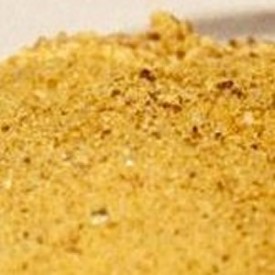
Powdered Myrrh
Description: "Myrrha chosen, fragill, or brittle, light, splendent, of little drops, bitter, sharpe, which smelleth sweete, full of whitish veynes being broken, ... openeth the wombe: procureth the courses [menstruation]: bringeth forth speedily the birth: good for the cough, stitch, fluxe, and bloudy flixe [bloody flux]: killeth wormes: amendeth the breath: closeth up wounds: confirmeth the teeth loose, and stayeth the hair shedding."5
"Myrrha, Myrrh. This is a resinous Gum, and comes from some Parts of Arabia and Ethiopia; that which is most clear, brittle, light, and fragrant of smell is best. It is of great use in Medicine, insomuch as to enter into Compositions [compound medicines] almost of all Intentions."6
"Myrrh, in Latin Myrrha. The best Myrrh is the cleanest, which is rough, light, and breaks easily, smells sweet, tastes bitter and hot. It heats, disposes to Rest, and is good in cold Diseases of the Head. It conglutinates [reunites bones and tissue], and dries. It provokes the Courses [menstruation], and hastens Delivery. 'Tis good for an old Cough, and Difficulty of Breating, and for Pains of the Breast and Sides, and for a Loosness, and for the Bloody-Flux. It cures an Hoarsness, being held in the Mouth, and what dissolves of it being swallow'd down. It heals Wounds of the Head, and is frequently applied to Bones when they lie naked. It was much used formerly to preserve dead Bodies. Some say, it is good in a Dropsie. 'Tis excellent in a Gangrene, for Swellings and Wounds, especially in the Head."7
1 John Woodall, the surgions mate, 1617, p. 106; 2 Thomas Brugis, The Marrow of Physick, 1669, p. 164; 3 Nicholas Culpeper, Pharmacopœia Londinesis, 1720, p. 46; 4,5 Woodall, p. 106; 6 John Quincy, Pharmacopoeia Officinalis & Extemporanea, 1719, p. 91; 7 John Pechey, The Compleat Herbal of Physical Plants, 1707, p. 305
Nux Muschata (Nutmeg)
Listed in: Woodall: Nux Muschata1
Category: Simple - Plant
Humoral Property: heating and drying2; "hot and dry in the second degree"3,
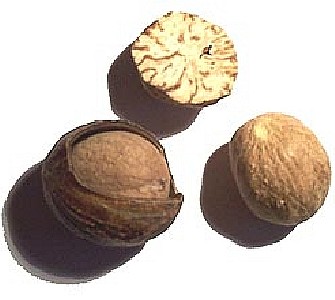
Nutmeg
Description: "Nux Muschata, or Nutmegs are of the same complexion as Macia [Mace]: helpeth the stoppings of the liver, milte [spleen], stomacke, windinesse of the belly, laske [looseness of the bowels], weaknesse of the kidnies, and stopping of the urine: comforteth the heart, and aromatizeth [gives a pleasant smell]."4
"Nux Moschata... The Nutmeg-Tree. It grows spontaneously in the Island of Banda, in the East-Indies, in great Plenty. ...The Fruit is brought to us preserv'd from India; but these are eaten to Excess, are said to have a narcotic Quality, and to produce a Delirium, or Sort of Intoxication."5
"Nux Moschatæ, of Nutmegs. This is a most delicate Aromatick Fruit, and enters into our Sauce [food] as well as our Physick. It is a great Comforter of the Head and Stomach; and likewise a good Carminative [preventer of gas], by its warm discussing [dissipating] Quality. But it is to be used sparingly, it will fume up too much, and prove offensive in the same manner as Perfumes to some particular Constitutions."6
1 John Woodall, the surgions mate, 1617, p. 104; 2 Robert James, Pharmacopoeia Universalis, 1747, p. 383; ,3,4 John Woodall, p. 104; 5 James, p. 382-3; 6 John Quincy, Pharmacopoeia Officinalis & Extemporanea, 1719, p. 84
Oleum Amigdalarum Amarus (Oil of Bitter Almonds)
Listed in: Woodall-Chest: Oleum amigd: amarar:1
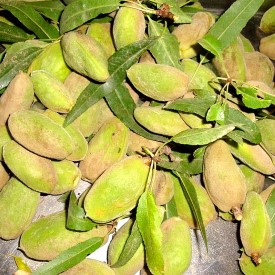
Photo: Ahmed-Najib Biabani Ibrahimkhel
Almonds
Category: Compound - Oils
Rx: "It is made like oyl of sweet Almonds, but that you need not blanch them [the bitter almonds], nor have such a care of heat, in pressing out the Oyl."1 (His explanation of how to make oil of sweet almonds: "Take of sweet Almonds not corrupted, as many as you will, cast the shells away, and blanch them, beat them in a stone mortar; beat them in double Vessels, and press out the Oyl without heat."2)
Description: "Oyle of bitter Almonds doth open obstructions discusseth [breaks up] winde and vapours: but chiefly it healeth deafnesse, the hissing and paine of the eares, lenifieth [softens] the hardnesse of the sinewes: and maketh the face and hands faire &c."3
1 John Woodall, the surgions mate, 1617, p. 74; 2 Nicholas Culpeper, Pharmacopœia Londinesis, 1720, p. 212; 3 Woodall, p. 74
Oleum Amigdalarum Dulcium (Oil of Sweet Almonds)
Listed in: Woodall-Chest: Oleum amigd: dulcium:1, Tweedy: Oleum Amygd. dulc.3

Photo: Ahmed-Najib Biabani Ibrahimkhel
Almonds
Category: Compound - Oils
Rx: "Take of sweet Almonds not corrupted, as many as you will, cast the shells away, and blanch them, beat them in a stone mortar; beat them in double Vessels, and press out the Oyl without heat."2
Description: "Oyle of sweet Almonds doth lenifie [soften] the roughnesse of the brest and throat, as also the hardnesse & drines [dryness] of the joints, is good against the consumption of the lungs [tuberculosis], it is also of good use to bee drunke in the hecticke fevers [hectic fever - recurring fever accompanied with sweating, chills and facial flushing]: it stayeth the cough, asswageth the heat of urine, healeth ulcers by injection: is very good in Colica Iliaca Passio [blockage of the intestine] to be drunke, and to be administred in glisters [clysters - enemas]."3
1 John Woodall, the surgions mate, 1617, p. 74; 2 "158. John Tweedy's Bill for Medicines. November 8, 1743". Privateering and Piracy in the Colonial Period Illustrative Documents, John Franklin Jameson, ed., p. 457; 3 Nicholas Culpeper, Pharmacopœia Londinesis, 1720, p. 212; 4 Woodall, p. 74
Oleum Lini (Linseed Oil)
Listed in: Woodall: Oleum Lini1, Tweedy: Oleum Lini2
Category: Compound - Oils

Photo: Wiki User Handwerker - From Flax To Linseed Oil
Rx: "Linseed Oil. Is procured by expression from bruised flax-seed. It also has the same properties as olive oil, but is nauseous and of a disagreeable odour. It soon becomes rancid. The spec. grav. Is 9403."3
Description: "Oyle of Linseed is anodine, cureth convulsions, mittigateth the hardnes of the arteries, muscles & nerves, asswageth the paine of the Hemorrhoides: and helpeth the unnaturall clefts, chaps, and fissures of the fundament [anus]."4
1 John Woodall, the surgions mate, 1617, p. 72; 2 "158. John Tweedy's Bill for Medicines. November 8, 1743". Privateering and Piracy in the Colonial Period Illustrative Documents, John Franklin Jameson, ed., p. 457; 3 James Rennie, A New Supplement to the Pharmacopœpias of London, Edinburgh, Dublin and Paris, Baldwin and Cradock, 1833, p. 282; 4 Woodall, p. 72
Oleum Olivarum (Olive Oil)
Listed in: Tweedy: Oleum Olivarum1
Category: Plant
Humoral Property: hot and moist2, "warming, and moistening"3

Photo: Consell Comarcal del Baix Empordà - Olive Oil
Description: "...the Oil express'd from the ripe Fruit [of the olive tree], is of ...general Use, being what we call Olive, or Sallad-Oil. It is ...emollient [softening], digestive [promotes growth of healthy flesh in a wound] and vulnerary [heals wounds]; it relaxes the Belly, is good for Dryness, and Strictures [tightening] of the Breast, mitigates Gripes [pains in the stomach], mollifies [softens], and relaxes the urinary Passages, and abstergesleans] and heals Erosions. It has lately been found by Experience, to be an absolute Cure for the Bite of a Viper, if well rubb'd into the Part wounded, before the Fire, and is at least; as effetual as the Oil of the Viper. Now as the viperine Poison, actus by coagulating the Blood in the Veins from the Part first affected towards the Heart, Oil in this Case must produce its salutary Effects, by preventing such Coagulation. This Circumstance, together with the frequent Use of Oils and Unctions, among the antient Physicians... makes me strongly suspect, that the external Use of Oil may be very powerful in preventing Coagulations of the Blood, when it is dipos'd to run into Concretions from other Causes besides the Bite of a Viper."4
1 "158. John Tweedy's Bill for Medicines. November 8, 1743". Privateering and Piracy in the Colonial Period Illustrative Documents, John Franklin Jameson, ed., p. 457; 2 Thomas Brugis, The Marrow of Physick, 1669, p. 166; 3,4 Robert James, Pharmacopoeia Universalis, 1747, p. 385
Opium
Listed in: Woodall-Chest: Opium1
Category: Simple - Plant
Photo: Den Haag
Incising for the Poppy Juice
Humoral Property: "light and fugacious [fleeting] calidity [heat], but a more valid and contumacious [willful] frigidity [coolness]"2; "colde and drie in the fourth degree"3
Description:"Opium ...asswageth [assuages - reduces] inward paines, causeth sleepe, stoppeth the flixe [flux]: and dessireth care in his use thereof, for otherwise is a deadly poyson."4
"Externally opium is sometimes said to be advantageously applied in form of ointment or liniment; as over the stomach to allay vomiting or spasm; along the spine in convulsions, &c., but it is not, I think, to be trusted alone. In form of enema or suppository, it is often powerful in dysentery and diarrhœa; and in form of a watery injection in spasmodic stricture, gonorrhœa, leucorrhœa [leukorrhea - white vaginal discharge], &c. Applied to a hollow tooth, it sometimes eases tooth-ache. It may also sometimes give relief to painful sores, such as open cancer, malignant fungus, irritable stumps after amputation, &c."5
"The concrete juice of the white poppy. Papaver somniserum.

Poppy (Papaver Somniferum) Crop - Malwa, India
A native of the south of Europe, and of the East. ...There are 40,000 pounds annually imported into London alone.
Procured by planting the young poppies in rows about six inches asunder; and at first watering them abundantly. When six or eight inches high, they are richly manuered, and again watered abundantly as they are about to flower. When the capsules or germens are about half grown, the collection of the opium commences, by making in each, at sun-set, two or three longitudinal incisions, taking care not to penetrate through to the cavity where the seed is lodged. Through these incisions the juice flows, and as it concretes, it is removed, and put into earthen pots, being afterwards dried in the sun. It is then formed into balls or cakes, and wrapped up in poppy or tobacco leaves, and again further dried."6
''Tis found frequently in Greece, in the Kingdom of Cambaia [Khambhat, India], and the Territories of Grand-Cairo in Egypt."7
1 John Woodall, the surgions mate, 1617, p. 97; 2 Jean de Renou, A Medicinal Dispensatory, 1657, p. 389; 3,4 Woodall, p. 97; 5 James Rennie, A New Supplement to the Pharmacopoeias, p. 293;6 Rennie, p. 290; 7 John Pechey, The Compleat Herbal of Physical Plants, 1707, p. 314
Opobalsamum (Balsam of Gilead)
Listed in: Woodall: Balsamum Naturale1
Category: Simple - Plant
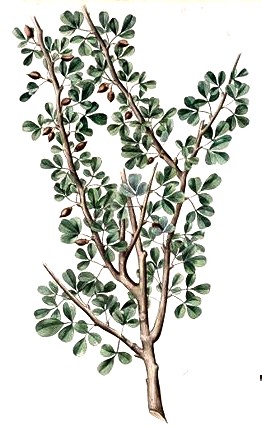
Artist: J. M. Pas
Balm Tree (Commiphora Gileadensis) -
Alleged
Source of Opobalsamum
Description: "Naturall Balsamum, or Opobalsamum is very good for them that are short winded, for the obstructions of the liver, and for griefes of the stomacke, helpeth the consumption of the lungs: and causeth an appetite, and besides the excellent vertue sanative [curative power] it hath, both inwardly and outwardly in the cure of wounds, It hath also many other good vertues."2
There is a great deal of debate about what is and isn't opobalsam in the period dispensatories.
"Many are of Opinion, that there is now no such thing as true Opobalsam, and that the genuine Species, of old produc'd in Egypt is not to be met with in any Part of the World; but [German physician Friedrich] Hoffman is of a different Opinion, because the Balsam of Mecha is of equal Efficacy with the Opobalsam of the Antients [First century physician Pedanis Dioscorides discusses it in his book de Materia Medica as does first century Roman author Pliny the Elder in his book Naturalis Historia]; for which Reason he concludes that to be the same. [This is very specious reasoning.]"3
"It is difficult to distinguish this from the Balsamum Verum, or Balsamum é Mecha, for [17th c. German Physician and Pharamacologist Johann] Schroder mentions them all as the same sort... Its medicinal Virtues are the same as those to which it bears so near a resemblance; with whom likewise it sometimes obtains a place amongst Alexipharmics [medicines for treating poisoning], and is a very good ingredient in [compound medicines] Theriaca Andromachi [Venice treacle] and Mithridate"4.
Jean de Renou says it comes from the Balm-tree "a peregrine shrub, growing formerly in Judea, Egypt and the valley of Syria, and most in Jericho; not very fair to look on, of a cineritious [dull grey] color... [Merchants] frequently vulnerate [wound] its crasser boughs and cauls [stalks] with a vitreous [glass], or an Ivory knife, at the beginning of Autumn; out of which scarification [little cuts] emanes [eminates] a crass juice-like Oil, which they call Balsamelæon or Opobalsamum."5
Renou goes on, "Amongst all Oils and Balsams, this is most approved and commended, whose faculties are inferiour to no Medicament in abigating [driving away] diseases, whether it be instrinsecally assumed [taken inwardly] or extrinsecally adhibited [applied externally], or mixed with other Medicaments."6
1,2 John Woodall, the surgions mate, 1617, p. 74; 3 Robert James, Pharmacopoeia Universalis, 1747, p. 248; 4 John Quincy, Pharmacopoeia Officinalis & Extemporanea, 1719, p. 137; 5,6 Jean de Renou, A Medicinal Dispensatory, 1657, p. 282
Opoponæx
Listed in: Woodall: Opoponæx1
Category: Simple - Plant
Humoral Property: hot [heating]2; "hott in the third degree, and dry in the second"3

Panax Hereculeum (Chelidonium majus) Plant, Inset (Photo: Antti Bilund) Showing
Resin Inside Cut Stem of Plant
Description: "Opoponæx, is a gumme... (if bitter, white within or yellow, fat, tender, easily dissolving, and of a strong smell, it is good) it doth mollifie [soften], digest [break down], attenuate [reduce the force of], or asswage, dissipate, or disperse winde, and is laxative."4
"Opoponax hath its name from Panax, whose succe [juice], or rather gummeous liquor [liquid] it is, which when concrete and dry, is subslave [yellowish] without, candid [white] within, graveolent [having a strong fetid smell], smooth, fat, fryable [crumbles easily], and easily liquescible [made liquid] in water."5
"Panax Herculeum... Alt. Hercule's All-heal. It grows in Gardens of the Curious, flowering in June. From the Stalk of this wounded, especially near the Root, during the Summer Months, a Juice flows which concretes spontaneously, and is called in the [apothecary] Shops Opoponax, which, if good, is externally of a yellow Colour, but internally whites, or somewhat inclining to yellow, of a bitter Taste, a strong Smell, and pinguinous [fatty] Consistence; it easily dissolves in Water, is light, friable, and when dissolv'd runs the Water milky. It mollifies, digests, discusses [disperses] Flatulencies, and purges thick and viscid Phlegm [one of the bodily humors], from the remote Parts, as the Brain, Nerves, Joints, and Thorax."6
1 John Woodall, the surgions mate, 1617, p. 104; 2 Nicholas Culpeper, Pharmacopœia Londinesis, 1720, p. 45; 3,4 Woodall, p. 104; 5 Jean de Renou, A Medicinal Dispensatory, 1657, p. 394; 6 Robert James, Pharmacopoeia Universalis, 1747, p. 394
Piper Nigrum (Black Pepper)
Listed in: Woodall: Piper nigrum1
Category: Simple - Plant
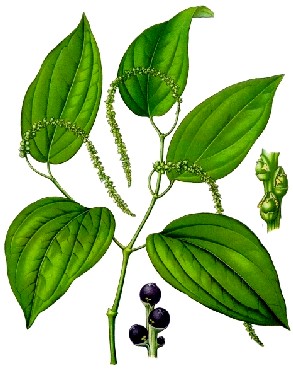
Artist: Franz Eugen Koehler - Piper Nigrum Plant (1897)
Humoral Property: hot [calefactive]2; "hot and dry in the third degree"3
Description: "Piper nigrum, or blacke pepper ...expelleth winde; is good against all cold griefes of the breast, and lungs: against poyson, agues [fevers] and squinancie [peritonsillar abscess, behind the tonsil]: dissolveth, and washeth hard tumors; causeth digestion: and aromatizeth meates."4
"Round Black Pepper, in Latin Piper Roturndum Nigrum. It grows in most Provinces in India, especially Malaca, Java and Sumetra. There is so much of it in those Places that it serves the whole World. The Plant is so weak, that it cannot stand by it self; and if it has not Tree to climb upon, it falls to the Ground like the Hops.
...All sorts of Pepper heat, provoke Urine, concoct [digest] and discuss [disperse], being taken inwardly; and used outwardly, they take off the Shaking Cold Fit of Agues, and are good for the Bititngs of Venemous Creatures. Pepper hastens Delivery, and is suppos'd to hinder Conception, being applied after Copulation. 'Tis good for Coughs and all Diseases of the Breast."5
1 John Woodall, the surgions mate, 1617, p. 103; 2 Jean de Renou, A Medicinal Dispensatory, 1657, p. 279; 3,4 Woodall, p. 103; 5 John Pechey, The Compleat Herbal of Physical Plants, 1707, p. 319
Pix (Navy Pitch)
Listed in: Woodall: Pix1
Category: Simple - Plant
Humoral Property: hot2; dry [sicce]3; "hot and drie in the second degree"4
Photo: Mats Halldin
Bucket of Naval Pitch, Becholmen, Stockholm Dry Docks
Description: "Pix Navalis, or stone-pitch ...discusseth [disperses], conglutinateth [causes adhesion], mollifieth [softens], maturateth [brings to a head], suppleth the hardness of the matrix [womb], and hard tumours, cureth ulcers, filleth them that are hollow up with good flesh, and helpeth cold aches."5
"Pix. Pitch. This is a Species of Gum obtained from the Pine Tree, by making Incisions in it. It receives different Names according to its different Preparations, Colour and Qualities. When it flows from the Tree, it is called Barras, but is afterwards distinguished into two Sorts, which have different Names: That which is most beautiful and clear, is called Galipot... [which] serves to make all the different Species of Pitch...
Black Pitch, which is properly that known by the Name of Pitch, is only Galipot, prepar'd in a particular Manner, but putting into it, when it is quite warm, a certain Quantity of Tar, in order to render it black. ...The best black Pitch comes from Norway and Sweden, to which that made in France, is by no means comparable. The Goodness of hard black Pitch consists in being of a shining black Colour, brittle, dry, and forming, as it were, Rays, when it is broken. What is called Pix Navalis in Medicine, ought to be the Pitch scraped off from Ships; but 'tis certain, that most Apothecaries use the common black Pitch in its stead."6
1 John Woodall, the surgions mate, 1617, p. 108; 2 Nicholas Culpeper, Pharmacopœia Londinesis, 1720, p. 71; 3 Jean de Renou, A Medicinal Dispensatory, 1657, p. 378; 4,5 Woodall, p. 108; 6 Robert James, Pharmacopoeia Universalis, 1747, p. 405-6
Pix Burgundiæ
Listed in: Woodall: Pix Burgundiæ1, Tweedy: Resin Comun.2
Category: Simple - Plant
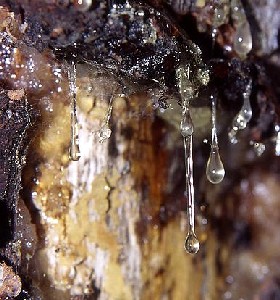
Photo: Wiki User Meanos - Pine Resin
Humoral Property: hot2; dry [sicce]3; "hot and drie"4
Description: "Pix Burgundiæ, of some Pix Greca and Colophonia. ...is all one thing, and is a kind of Rosine of the Pine tree, it is [good for] ...clensing and healing new wounds, mollifying [softening] hard tumours or swellings, and is very profitable against aches of the limbs, proceeding of a colde cause."5
"Pix. Pitch. This is a Species of Gum obtained from the Pine Tree, by making Incisions in it. It receives different Names according to its different Preparations, Colour and Qualities. When it flows from the Tree, it is called Barras, but is afterwards distinguished into two Sorts, which have different Names: That which is most beautiful and clear, is called Galipot... [which] serves to make all the different Species of Pitch describ'd in this Article. The pinguous Pitch, which is, also, called white Burgendy Pitch, is Galipot melted with Oil of Turpentine. Some however assert, that the Burgendy Pitch flows naturally from Resinous Trees, in the Mountains of Franche Comté ["free country" in Eastern France]. "6
1 John Woodall, the surgions mate, 1617, p. 107; 2 Nicholas Culpeper, Pharmacopœia Londinesis, 1720, p. 71; 3 Jean de Renou, A Medicinal Dispensatory, 1657, p. 378; 4,5 Woodall, p. 107; 6 Robert James, Pharmacopoeia Universalis, 1747, p. 405
Polypodium
Listed in: Woodall: Polypodium1
Category: Simple - Plant
Humoral Property: "drie in the second degree"2
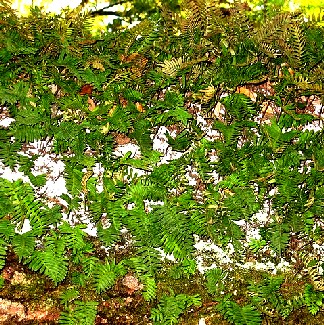
Photo: Wiki User DanielCD
Pleopeltis Polypodioides Growing On Oak Tree Limb
Description: "Polypodium ...openeth the body, and bringeth away blacke choler [black bile, one of the bodily humors], and phleme [phlegm, another bodily humor], helpeth the collicke, and the griping [pain] of the belly, and also the obstructions of the spleene."3
"Polypodii. Polypodium, or Fern of the Oak. It is a gallant though gentle purger of Melancholy [black bile]: Also in the opinion of Mesue [8th/9th Assyrian physician Yuhanna ibn Masawaih] (as famous a Physitian as ever I read for a Galenist) it dries up superfluous Humours, takes away swellings from the hands, feet, knees and joynts, stitches and pains in the sides, infirmities of the Spleen, Rickets: correct it with a few Annis seeds, or Fennel seeds, or a little Ginger, and then the stomach will not loath it. Your best way of taking it, is to bruise it well, and boil it in white Wine till half be consumed, you may put in much or little, according to the strength of the Diseases, it works very safely. I can give no better reason why Polypodium of the Oak should be best, unless because 'tis the rarest, it draws either very little sap from the Oak, or none at all; as if it did, the reason were as far to seek. I am of the opinion, that which grows on the ground is the best to evacuate Melancholly, but it is more Sympathetical."4
The name polypodium refers to "a genus of 75–100 species of true ferns, widely distributed throughout the world"5. Apothecary John Quincy says of the Polypodii, "It grows in an odd manner out of old Walls, and Ruins; as likewise out of many Trees, but that from the Oak is reckon'd best."6 This points to the Resurrection Fern Pleopeltis polypodioides, which is "an epiphyte, or air plant, which means it attaches itself to other plants and gets its nutrients from the air and from water and nutrients that collect on the outer surface of bark."7
1,2,3 John Woodall, the surgions mate, 1617, p. 95; 4 Nicholas Culpeper, Pharmacopœia Londinesis, 1720, p. 10; 5 "Polypodium", wikipedia.com, gathered 6/7/15; 6 John Quincy, Pharmacopoeia Officinalis & Extemporanea, 1719, p. 142; 7 "Pleopeltis polypodioides", wikipedia.com, gathereed 6/7/15
Pulpa Tamarindorum (Tamarind Pulp)
Listed in: Woodall-Chest: Pulpa Tamarindorum1
Category: Simple - Plant
Humoral Property: cold and dry in the second degree2; cold in the third degree, dry in the second3
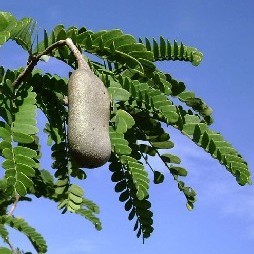
Photo: Tau Olunga - A Tamarind
Description: "Pulpa Tamarindorum, the pulpe or juice of Tamarinds is a medicament excellent and well approved against the Scurvy, as well for opening the obstructions of the liver and spleene, as for comforting and refreshing the bloud and spirits decayed or stopped. Also it purgeth choler [yellow bile, a bodily humor]: allaieth [allays - diminishes] the heate, and furie of bloud [blood is also a bodily humor]: cureth sharpe fevers, and the Kings evill [scrofula, or struma, a tuberculous swelling of the lymph glands]: extinguisheth thirst, & all heate of the stomacke and liver: stoppeth vomiting, and is good for the Collick."4
"These fruits, when immature, are green and acid; when mature, they are cineritious [like ashes], their acidity not without suavity. ...They gently subduce [reduce] the belly, leniate [sooth], temperate, and promote adust [melancholy - black bile] humours"5.
"Tamarindi, Tamarands. This is the Fruit of an Indian Tree of the Palm kind, and not greatly unlike the English Ash in manner of Growth. ...They come to us now from both the Indies, and are either blackish or red. The latter are prefer'd. The Sailors are apt to enlarge their Bulk with too much Sugar, for a little does not hurt them. They are acid, pleasant, and cooling; and gently relax the Bowels. For this reason they are in the Lenitive Electuary, and also prescribed in burning Fevers, to moisten and cool the Mouth, by sucking and gradually swallowing them."6
1 John Woodall, the surgions mate, 1617, p. 89; 2 Nicholas Culpeper, Pharmacopœia Londinesis, 1720, p. 43; 3 Jean de Renou, A Medicinal Dispensatory, 1657, p. 254; 4, Woodall, p. 89; 5 Renou, p. 254; 6 John Quincy, Pharmacopoeia Officinalis & Extemporanea, 1719, p. 182
Pulvis Liqueritiæ (Powdered Licorice)
Listed in: Woodall-Chest: Pu: Liqueritiæ1
Category: Simple - Plant
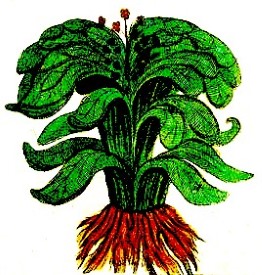
Artist: Michael Boym
Rhubarb From Bibliotheque Universtaire
Moretus Plantin (1656)
Humoral Property: hot2
Description: "Pulvis Glycirrhizæ. Liquorice Powder. This is prepared by pulverizing liquorice root, and is used for dusting excoriations, for enveloping pills to prevent their adhering together, &c."3
"Liquirice... is agreeable to the lungs and breast, rotteth phlegm [one of the four bodily humors], moveth expectoration [mucus and phlegm in the lungs], cureth the cough, helpeth breathing, and is profitable for the reins [kidneys], taking away the sharpness of the urine, and healeth the sores of the kidneys and bladder."4
"The Roots, which are the only Parts used, are pectoral, and of great Use in Disorders of the Lungs, as Cough, and Shortness of Breathing. They, also, mitigate the acrimonious Particles which cause Soreness in the Aspera Arteria [trachea], and Hoarseness. They are, also, good in nephritic Disorders, as the [bladder] stone, Gravel, Heat and Retention of Urine, and Ulcers in the Kidneys"5
1 John Woodall, the surgions mate, 1639, Diagram opp. page 26; 2 Thomas Brugis, The Marrow of Physick, 1669, p. 145; 3 James Rennie, A New Supplement to the Pharmacopœpias of London, Edinburgh, Dublin and Paris, Baldwin and Cradock, 1833, p. 263; 4 Brugis, p. 145; 5 Robert James, Pharmacopoeia Universalis, 1747, p. 327-8
Pulvis Olibanum (Powdered Thus or Frankincense)
Listed in: Moyle: Pulvis Thus1 Tweedy: Myrrh. Pulv.2
Category: Simple - Plant
Humoral Property: hot in the second degree, dry in the first3; hot [califies] in the second degree, dries [siccates] in the third4
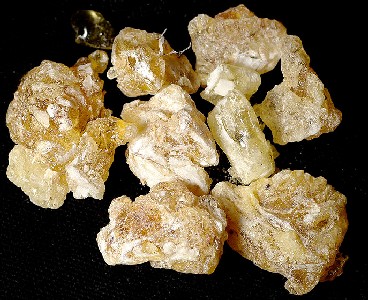
Photo: Wiki User snotch - Frankincense (Or Thus or Olibanum)
Description: "Thus...binding somewhat, inwardly for divers diseases of the head and breast, and fluxes [flows, probably referring to diarrhea], coughs; outwardly fills ulcers with flesh, heals redness of the eyes, mixt with Womans milk and aq. ros. first impregnated with often extinction of thus, and made into a liquid collyrium [medicine for treating the eyes]."5
"Manna Thuris. The small fragments or dust produced by the friction of the above [Juniperi lyciæ gummi-resina] in carriage [This is not entirely clear. It may just mean when frankincense is carried, dust is produced by the pieces are rubbing together.]"6
1 John Moyle, The Sea Chirurgeon, 1693, p. 32; 2 "158. John Tweedy's Bill for Medicines. November 8, 1743". Privateering and Piracy in the Colonial Period Illustrative Documents, John Franklin Jameson, ed., p. 460; 3 Thomas Brugis, The Marrow of Physick, 1669, p. 163; 4 Jean de Renou, A Medicinal Dispensatory, 1657, p. 381; 5 Samuel Frederick Gray, A Supplement to the Pharmacopoeia, 1821, p. 189; 6 Brugis, p. 163
Pulvis Sanguis Draconis (Powdered Dragon's Blood)
Listed in: Moyle: Pulvis Sang. Draconis1, Tweedy: Pulv. Ling. Dracon.2
Category: Simple - Plant
Photo: Andy Dingley - Powdered Dragon's Blood
Description: "Sanguis Draconis, Dragon's-Blood. It is the Weepings of a Tree which bears a Fruit not unlike a Cherry; the Skin of which pull'd off, they say resembles a Dragon. It is experienced to be of an aglutinating Quality, and is prescribed with success in most Fluxes and Hemorrhages. Its principal share in Composition is in the Lucatellus Balsam, as some make it. 'Tis esteem'd a good Ingredient likewise in strengthning Plasters."3
"Draco arbor... The Dragon Tree. This grows in Porto Santo which is one of the Canaries, and in Madera. Dragon's Blood, is the Gum of this Tree. This is a Resin of a redish Colour, easily melted by the Fire, and kindling into Flames, when thrown into it. There are two Sorts to be met with in the [apothecary] Shops, which only differ in being more or less pure. The Curious generally make the Dragons Blood of the Moderns, for the Cinnebar of Dioscorides. This Gum is a powerful Drier, Astringent [medicine to draw the flesh together] and Repellant, but is principally used externally, for drying up Defluxions, stopping Hemorrhages, conglutinating Wounds, and fastening loose Teeth."4
1 John Moyle, The Sea Chirurgeon, 1693, p. 32; 2 "158. John Tweedy's Bill for Medicines. November 8, 1743". Privateering and Piracy in the Colonial Period Illustrative Documents, John Franklin Jameson, ed., p. 458; 3 John Quincy, Pharmacopoeia Officinalis & Extemporanea, 1719, p. 97; 4 Robert James, Pharmacopoeia Universalis, 1747, p. 311
Pulvis Scammonium
Listed in: Tweedy: Pulv. Scamo.1
Category: Simple - Plant
Humoral Property: hot and dry in the third degree2; " hot and drie in the second degree"3
Photo: Eitan F. - Scammony (Convolvulus Scammonia)
Description: "Scammony, in Latin Scammonium. The best comes from Antioch [Greece]; 'tis clear, splendid, melts easily, and breaks easily, is not very weighty; being touched with the Tongue it grows milky, when it is broken 'tis yellowish; but that which we have commonly is of an Ash-colour, and looks ill, because it is not the Liquor or Tear flowing from the Plant, but the Juice press'd out. It purges strongly Cholerick [yellow bile, one of the bodily humors], Watery and Sharp Humours from the remote Parts, and therefore is frequently used for such Purposes [treating gout would be an example of this]. The Dose is, from six Grains to a Scruple. But it is most commonly used mix'd with some other thing."4
"All Scammony purges violently, moving the bellyeith labour and molestation; it expunges flegm [phlegm, one of the bodily humors], an watry, thin and sharp humours; and if it be too largely assumed, it abrades the intestines, hurts the bowels, opens and erodes the orifices of the beins, draws blood downwards, excites the dysentery, conturbates the heart, liver, and other intrals, and subverts the ventricle"5.
1 "158. John Tweedy's Bill for Medicines. November 8, 1743". Privateering and Piracy in the Colonial Period Illustrative Documents, John Franklin Jameson, ed., p. 460; 2 Jean de Renou, A Medicinal Dispensatory, 1657, p. 264; 3 John Woodall, the surgions mate, 1617, p. 94; 4 John Pechey, The Compleat Herbal of Physical Plants, 1707, p. 330; 5 Renou, p. 264
Radix Althææ (Marshmallow/Hollyhock Roots1)
Listed in: Woodall: Radices Altheæ2
Category: Simple - Plant
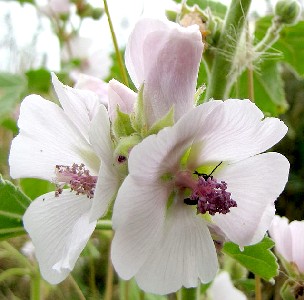
Photo: Phil Sellens - Marshmallow (Althaea Officinalis )
Humoral Property: "mainly hot"3; "hot and moist"4; "hot and drie in the first degree"5
Description: "Radix Altheæ Hollihocke roots ...are profitable for the gravell, [kidney] stone, bloudy flixe [bloody flux], tooth-ach, Sciatica, and cough; they cure new wounds, dissolve cold tumors, wennes [sties], hard kernels, impostumes [pus-filled abcesses], sores of the mother, and chaps of the fundament [anus], are good for cramps, burstings, and for trembling of the members [palsey?]."6
“Althæa. ...Marsh-mallows. It grows in Salt Marshes and maritime Places, flowering in the Months of July and August, producing Seeds in September and October. The whole plant contains a Juice, which is glutinous, highly soft, free from all Acrimony, and proper where there is an excessive Exsiccation [dryness], Rigidity, or Contraction of the Fibres; or where there is an Acrimony, or too violent a Motion of the Blood. We use the Leaves or Herb, which is one of the five emollient Herbs, the Flowers, the Seeds, and most frequently the Root, because it is more mucilaginous than the other Parts. These are all used both internally and
Photo: Vincente Selvas - Marshmallow Roots
externally, in Decoction, Clysters, Balsams, Fomentations, Cataplasms, Ointments, and Plaisters, whenever the Intention is to mollify [soften], mitigate [lessen the severity], and allay. In preparing Decoctions for internal use, the Marsh-mallows is to be added towards the End, least they should become too thick and glutinous. The Plant is most commended in violent Disorders of the Breast and Kidneys, as in an Heat and Retention of Urine, and nephritic Colics. It is also an Ingredient in pectoral [respiratory] Troches. … The Root of this Plant is also prescribed to be chewed in the difficult Dentition [teething] of Infants. It is also used for rubbing the Teeth, in order to cleanse them, but in order to disguise it, it is tinged with a red Colour, by boiling it with red Sanders and some Alum, or with red Wine. Sometimes the Mucilage of the Roots and Seeds is used; for which Purpose these two Parts of the Plant are macerated [softened by soaking] in Water to become glutinous, then the Mucilage is expressed thro’ a linnen Cloth, and has a proper Quantity of Sugar mixed with it. The external Use of this Preparation, is highly efficacious in Fissures of the Nipples, and Womens Breasts, and all other Excoriations."7
1 The genus althaea used to contain both marshmallow and hollyhock plants, but they have since been separated into althaea (marshmallow) and alcea (hollyhock) genera. This may explain the differences in the humoral properties. Or it may not. 2 John Woodall, the surgions mate, 1617, p. 121; 3 Thomas Brugis, The Marrow of Physick, 1669, p. 151; 4 Nicholas Culpeper, Pharmacopœia Londinesis, 1720, p. 1; 5,6 Woodall, p. 121; 7 Robert James, Pharmacopoeia Universalis, 1747, p. 222-3
Radix Angelicæ (Angelica Roots)
Listed in: Woodall: Radices Angelicæ1
Category: Simple - Plant
Humoral Property: hot and dry in the third degree2; hot and dry in the second degree3; "hot and drie in the second degree"4
Wild Angelica Sylvestris
Description: "Radices angelicæ Angelical roots ...doe open, attenuate [reduce the force of], digest [break down], cut and discusse [disperse] grosse humours, they are adversary to poison, helpe pestilent diseases, cause the flowers [menstruation], comfort the heart, and vitall poures [vital pores - probably referring to those that were thought to connect directly to the heart]."5
"Angelica. Botanists enumerate various Species of this Plant, but that most used in Medicine is thus distinguished Angelica... It flowers and produces Seeds in June and July, the Roots perishing after the ripening of the Seeds, which is in the second Year. This is a Plant of an highly penetrating and aromatic Nature; its Seeds and Roots are in a particular Manner resolvent [separating elements in the body] and stimulating, and consequently sudorific [sweat-inducing], alexipharmic [poison preventing], and proper to expel the pestilential Poison by Sweat. The Root is thought best, which when chewed, has the Taste and Smell of Ambergrease and Musk mixed together, and spreads a Kind of penetrating Gratefulness all over the Mouth, without exciting any Inflammation. Hence and Infusion or a gentle Decoction of it, is commended against a fetid Breath, and when used in the same Manner, it is said to be beneficial in Coughs arising from Cold, or a viscid Mucus; because it renders Respiration more free and easy. From what has been said we may know, why the whole Plant has been classed among the carminative [those that prevent formation of gas] Medicines, and for that Reason some recommend a Dram of its dried Powder, taken with Wine, or Rob of Elder, in intermittent Fevers. In medicine the Root is more frequently used than the Seeds, while the Leaves are entirely Neglected. ...The Root macerated [softened by soaking] in Vinegar, is in the Plague reckoned a great Preservative by many, who keep a Piece of it in their Mouths, when they go to visit the Infected. The Root and Stalks preserved answer the same Intention, and a Confection of the Seeds is highly proper for those who would guard against the Injuries of a malignant Air. ...It is externally ordered against the Bites of venemous Animals, and some recommend it as an Ointment to be used by those afflicted either with the Gout, or Ischiadic [sciatic] Pains."6
1 John Woodall, the surgions mate, 1617, p. 122 (mislabeled as 130); 2 Nicholas Culpeper, Pharmacopœia Londinesis, 1720, p. 1; 3 Jean de Renou, A Medicinal Dispensatory, 1657, p. 298; 4,5 Woodall, p. 122 (mislabeled as 130); 6 Robert James, Pharmacopoeia Universalis, 1747, p. 231-2
Radix Bardanæ (Burdock Root)
Listed in: Tweedy: Rad. Bardan1
Category: Simple - Plant
Humoral Property: dry2; "temperately hot and dry"3
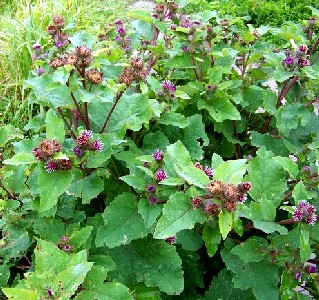
Photo: Trish Steel - Greater Burdock (Arctium lappa)
Description: "Burdock, the roots are ...pumonic [good for the lungs], diuretick, good for the Gout, tumor of the Spleen."4
"Burdock, in Latin Bardana. It has a single, thick Root, that grows deep in the Earth; without black, within white. ...'Tis Drying, Pulmonick [good for problems of the lungs], Diuretick, Diaphoretick [causes sweating], Cleansing, and somewhat Astringent [contracts the tissues]. 'Tis good in an Asthma, for the [kidney] Stone, and Spitting of Blood; for old Sores, and Swelling of the Spleen, and of an other Parts in Gout Diseases, wherein it is peculiarly proper."5
"Bardana, the Name of a Plant of of [sic] which there are several Species... Burdock. It grows almost every where by the Way-sides, and flowers in June and July. The Roots, Leaves and Seeds are used. The Roots are sudorific [cause sweating], alexipharmic [prevent poisoning], and good in malignant Fevers... They are, also, used against the Gout and Pains in the Limbs."6
1 "158. John Tweedy's Bill for Medicines. November 8, 1743". Privateering and Piracy in the Colonial Period Illustrative Documents, John Franklin Jameson, ed., p. 459; 2 Thomas Brugis, The Marrow of Physick, 1669, p. 147; 3 Nicholas Culpeper, Pharmacopœia Londinesis, 1720, p. 2; 4 Brugis, p. 147; 5 John Pechey, The Compleat Herbal of Physical Plants, 1707, p. 36; 6 Robert James, Pharmacopoeia Universalis, 1747, p. 250-1
Radix Chyna (China Root)
Listed in: Woodall: Radix Chyna1, Moyle: Rad. Chyna2, Tweedy:Rad. Chinae3
Category: Simple - Plant
Humoral Property: dry4; hot5
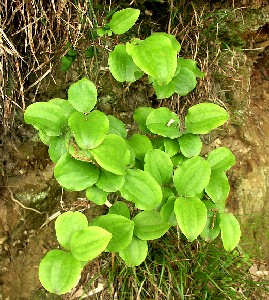
Photo: Wiki User Cory - Smilax China Plant
Description: "Radix Chyna, Chyne-roots prevaile much in the cure of Lues verenea [syphilis], and are good for the giddinesse of the head, taketh away the paine of the stomacke, & obstructions, and are profitable for the dropsie [edema], chollike [cholic], and gripings of the belly, moveth urine, causeth sweat, and are helpful against convulsions, the palsi and paines of the joints, and a singular remedie against a consumption [tuberculosis]."6
“China [Smilax China] wonderfully extenuateth [lessens the heat] and dryeth, provoketh sweat, resisteth putrifaction, it strengthens the Liver, helps the Dropsie and malignant Ulcers, Leprosie, Itch and French Pox, and is profitable in Diseases coming of Fasting."7
“It grows in the vast region of Chyna, which terminates in the East-Indies, and Scythia, not in mountainous and dry ground, as some have conjectured, but in fens [low, marshy ground] and moyst places like a reed as about the sea-shore, or head of some fountain.
Its root is crass and nodous [knobby], as red roots, hard also, and tuberous, like the Brambles root; and ruberous [red] and tortuous [full of twists], like Bistorts root. Slender and imbecile cauls [stalks] erupt out of its root, which are circumcinged [encircled] with very rare leaves; which though low, require fulciments [fulcrums], that they may be strait."8
1 John Woodall, the surgions mate, 1617, p. 97; 2 John Moyle, The Sea Chirurgeon, 1693, p. 33; 3 "158. John Tweedy's Bill for Medicines. November 8, 1743". Privateering and Piracy in the Colonial Period Illustrative Documents, John Franklin Jameson, ed., p. 460; 4 Nicholas Culpeper, Pharmacopœia Londinesis, 1720, p. 4; 5 Jean de Renou, A Medicinal Dispensatory, 1657, p. 290; 6 Woodall, p. 97; 7 Culpeper, p. 4; 8 Jean de Renou, A Medicinal Dispensatory, 1657, p. 289
Radix Consoledæ Majoris (Comfrey Root)
Listed in: Woodall: Radices Consoledæ Majoris1
Category: Simple - Plant
Humoral Property: cold2; cold [refrigerates]3; "hot and drie in the second degree"4
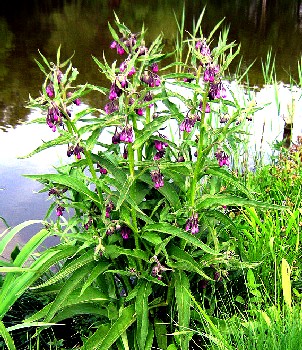
Photo: Wiki User Noval - Comfrey (Symphytum officinale)
Description: "Radix symphiti magni, seu consolidæ majoris, or Comfrey roots ...doe helpe spitting of bloud, the breast, and lungs, cureth the inward wounds, and ruptures, are glutinative [adhesive], mitigate [lessen the severity of] hot tumours, and heale fresh wounds."4
It is curious that Woodall says that comfrey roots are hot and dry and yet says they mitigate hot tumors, especially since other authors list it as a cold medicine.
"Symphytum Consolida major, ...Comfrey. It is found in Ditches, flowering in May. The Root, Herb, and Flowers are us'd. The Leaves are insipid [lacking flavor], glutinous, and give a very faint Tincture of Red to the blue Paper5; the Roots give it [the tincture] a little deeper, and abound with a viscid Juice. ...The Root is insipid, but very demulcent [relieves inflammation], and the Juice is very good in Hæmoptoe [spitting of blood] from an excessive Tenacity, and in Hernias. A Cataplasm of the Root is effectual in Punctures of the Tendons. The Herb is good in a Dysentery, and an Exulceration [soreness] of the Kidnies and Bladder from Cantharides [spanish flies, used to irritate the skin]; it is exhibited like the Althæa, but in a smaller Dose, because of its greater Mucosness."6
"It grows in Watery Places, or near Rivers; and flowers in May."7
1 John Woodall, the surgions mate, 1617, p. 122 (mislabeled as 130); 2 Nicholas Culpeper, Pharmacopœia Londinesis, 1720, p. 4; 3 Jean de Renou, A Medicinal Dispensatory, 1657, p. 350; 4 Woodall, p. 122 (mislabeled as 130); 5 Paper used to wrap sugar at this time was blue. It is quite possible that roots and dried herbs may have been similarly wrapped in blue paper, although James does not state this specifically. (See Irene Brückle's "Historical Manufacture and Use of Blue Paper" for more information on blue paper.); 6 Robert James, Pharmacopoeia Universalis, 1747, p. 450-1; 7 John Pechey, The Compleat Herbal of Physical Plants, 1707, p. 58
Radix Gentianæ (Gentian Root)
Listed in: Tweedy: Rad. Gentian.1
Category: Simple - Plant
Humoral Property: cold, yet pretty temperate2

Gentian Verna
Description: "Radix Gentinanæ. Gentian Roots. No part of this Plant besides [the root] is used in Medicine, and the Root [17th c. German Physician and Pharamacologist Johann] Schroder tells us should be taken up in August and September. It is extremely bitter, but leaves rather an agreeable than nauseous Gust [taste] behind. It deservedly stands at the head of the Stomachick Class [medicine for treating the stomach], as it wonderfully warms the stomach, and excites the Appetite; and also as it enables it the better to digest what it receives. The Subtilty of its Parts makes it also pass for a Discutient [disperser of matter] and Aperient [laxative], in many Compositions of those Intentions; and likewise for an Alexipharmic [treatment for poison], and a great Antidote against many kinds of Poisons, as it wonderfully promotes both sensible and insensible Perspiration. For killing and expelling Worms, it is in the best esteem: and in Chirurgery it not only goes for a Discutient in their Fomentations, but is also used in fine Powder to Issues, to promote their running, and as a Tent, both to enlarge and cleanse some Fistulous Apertures. ...by its great Subtilty and Heat, if Caution be not used, it will inflame in many cases rather than abate the Symptoms"3.
"It It is excellent for all Wounds, both Internal and External, or spitting of Blood, Ruptures or burstuess [probably burstness, referring to burstings], pains in the back, it strengthens the Reins [kidneys and lower back], it stops the Terms [menstruation], and helpeth the Hermorrhoids. The way to use [the roots] is to boil them in water, and drink the Decoction."4
1 "158. John Tweedy's Bill for Medicines. November 8, 1743". Privateering and Piracy in the Colonial Period Illustrative Documents, John Franklin Jameson, ed., p. 459; 2 Nicholas Culpeper, Pharmacopœia Londinesis, 1720, p. 4; 3 John Quincy, Pharmacopoeia Officinalis & Extemporanea, 1719, pp. 110-1; 4 Nicholas Culpeper, p. 4
Radix Glycyrrhizæ {Licorice Root)
Listed in: Tweedy: Rad. Liquorit.1
Category: Simple - Plant

Photo: Raffi Kojian - Licorice (Liquiritiae)
Humoral Property: hot and moist2; "temperate in all qualities, but ascedes nearer to calour [heat]"3
Description: "Liquorice ...is agreeable to the lungs and breast; rotteth phlegm [one of the bodily humors], moveth expectoration [removes mucus from the lungs] cureth the cough, helpeth breathing, and is profitable for the reins [kidneys], taking away the sharpness of urine, and healeth the sores of the kidneys and bladder."4
"Glucyrrhizæ, Liquorice. There is not perhaps any one Simple so much used in Medicine as this is, both in the [apothecary] Shops and extemporaneous Prescriptions [from the Latin 'ex tempore' ("at the time") - a prescription written on the spot for a specific patient with a specific ailment]. It grows in many parts of Europe, and we have enough of it in England for our own Supply... Its chief place of Growth here is about Pontrefract in Yorkshire. It is very sweet upon the Palate, even more than Sugar or Honey, and yet accounted a
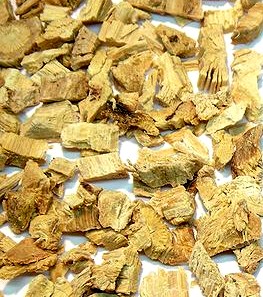
Photo: Alcibiades - Grated Licorice Root (Liquiritiae)
Slaker of Thirst... It is very Balsamick and Detergent [purging], insomuch that there is hardly an official Medicine, or occasional Prescription for any Distempers of the Breast, but what have more or less of this for an Ingredient. Altho it is so very detergent, that some have suspected its too liberal use to have brought on sometimes a spitting of Blood, yet it has likewise somewhat so soft and even emollient in its Composition, as to soften tickling Defluxions [flows of liquid, probably in the throat], and give relief in Catarrhs [congestion caused by mucus build up]; which makes it of great esteem in Coughs of all kinds. It promotes Expectoration, and is serviceable in Asthma's, Difficulties of Breathing, Pleurisies, and Tubercles, and Erosions of the Lungs. For these Intentions it enters into Pectorals [medicines for treating problems with the respiratory tract] of all forms. It is almost as contant likewise amongst the Deobstruents [medicines to remove obstructions]; and is prescribed in the Jaundice, in Hypochondriacal Affections [problems affecting the upper part of the abdomen on either side] , and amongst Diureticiks. It has its share also as a Corrector of some Catharticks [purging medicines]... In short, it is almost of univeral use, and is hardly superfluous in any one Intention. ...what is made here [England] from our own Roots, is much the best; altho what comes from abroad is cheapest and therefore most frequently to be met with."5
1 "158. John Tweedy's Bill for Medicines. November 8, 1743". Privateering and Piracy in the Colonial Period Illustrative Documents, John Franklin Jameson, ed., p. 459; 2 Nicholas Culpeper, Pharmacopœia Londinesis, 1720, p. 8; 3 Jean de Renou, A Medicinal Dispensatory, 1657, p. 304; 4 Thomas Brugis, The Marrow of Physick, 1669, p. 145; 5 John Quincy, Pharmacopoeia Officinalis & Extemporanea, 1719, p. 141
Radix Hermodactyli (Hermodactyl Root)
Listed in: Woodall: Hermedactili1
Category: Simple - Plant
Humoral Property: hot and dry2; hot [califies] and dries [siccates} in the beginning of the second degree3; "hot, and drie in the second degree"4
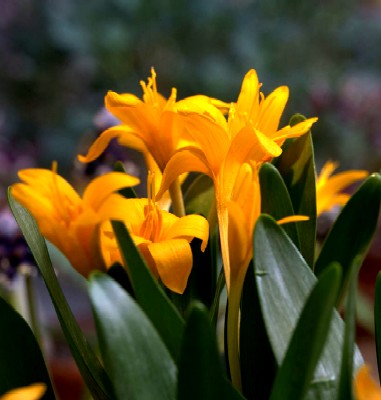
Photo: Gustav Svensson - Hermodactyl (Colchicum luteum)
Description: "Hermedactili ...effectually drawe away phleame [phlegm, one of the bodily humors], and other slimie humors from the articles [extremities?], and therefore are very profitable for the Goute in the hands, and the Sciatica."5
"Hermodactyli, Hermodactils. These are a Root, as most say, brought from Syria. Mathiolus [16th century Italian physican and herbalist Pietro Andrea Gregorio Mattioli], with many more, will have that which is in the [apothecary] Shops under this name, a Species of the Flower-de-Luce root; but others dissent from this Opinion. This stands so much in the account of some Writers, as to be dignfy'd with the name of Anima Articulorum, the Soul of the Joints; because they believ'd it to be so very efficacious in scouring the mucilagainous Glands, and preserving them from the Lodgment of such gritty Matter, as occasions the Gout and Arthritick Compaints. This is of the kind of Catharticks [purging medicines], which exert not themselves but in the smallest Passages, and therefore are slow in Operation, although of great consequence in their Effects."6
"Botanists do not agree about Hermodactyls of the Shops. Some say they are the Roots of Cochicum: Others deny it: And the more Learn'd and Skilful make them to be different things."7 Modern authors suggest Hermodactyl roots were likely taken from the Colchicum luteum plant, although even they are not certain.
1 John Woodall, the surgions mate, 1617, p. 95; 2 Nicholas Culpeper, Pharmacopœia Londinesis, 1720, p. 8; 3 Jean de Renou, A Medicinal Dispensatory, 1657, p. 262; 4,5 Woodall, p. 95; 6 John Quincy, Pharmacopoeia Officinalis & Extemporanea, 1719, p. 184; 7 John Pechey, The Compleat Herbal of Physical Plants, 1707, p. 284
Radix Jalapium (Jalap Root)
Listed in: Moyle: Jalap1
Category: Simple - Plant
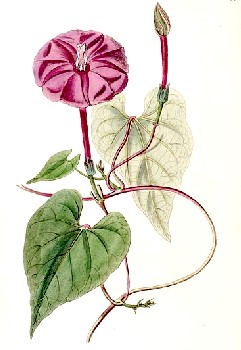
Ipomoea Purga, Source of Jalap Root, From
Edwards Botantical Register, p. 49 (1847)
Description: "Jalapium Mechoacana nigra... Jalap. The Root is used, which is brought to us from the Indies, the Root only is used which powerfully purges all noxious [harmful], but more in particular, all serous [watery] Humours. [17th century Swiss pharmacologist Johann Jakob] Wepfer in his Treatise de Cicuta Aquatica says, it is one of the best Cathartics [purging medicines] we have, and wonders it is so little used, since, it wants no Corrector [an additive medicine to reduce the force of its purge] on one Hand, nor any thing on the other to promote its Operation, which can hardly be said of any other Purgative; as one Part of the Root may abound more with the purgative Quality than an other the Dose of the Resin is much more certain."2
"Jalapii, Jalap. ...it is brought to us chiefly from Peru and New-Spain [South and Central America]. The Mechoacan and this are reckon'd of a Species; and therefore as this is sometimes called Mechoacana nigra, that goes as often by the name Jalapium Album.... That which breaks blackest, most brittle, sound and shining within side, is best; by reason the resinous Parts, which give in those Properties, are suppos'd to contain its medicinal Virtues."3
"The Root of it is like Mechoacan, but it is cover'd with a black Bark, and is brownish within. It comes to us sliced from India. It tastes Gummy, but not unpleasant. Tis stronger than common White Mechoacan, for it purges Watery Humours better. A Dram of the Powder of it may be given at a time."4
1 John Moyle, The Sea Chirurgeon, 1693, p. 33; 2 Robert James, Pharmacopoeia Universalis, 1747, p. 344; 3 John Quincy, Pharmacopoeia Officinalis & Extemporanea, 1719, p. 193; 4 John Pechey, The Compleat Herbal of Physical Plants, 1707, p. 285
Radix Pyrethri (Pellitory Root)
Listed in: Woodall: Radices Pyrethri1
Category: Simple - Plant
Humoral Property: hot and dry in the fourth degree2; cool [refrigerative]3; "hot & drie in the third degree"4

Photo: Jerry Friedman - Pellitory of Spain (Anacyclus pyrethrum depressus)
Description: "Radices pyrethri or Pellitory roots are ...good for old cold diseases of the head, & braine, falling sicknesse [epilepsy], and apoplexie [unconsciousness], mittigateth the tooth-ach chewed, bringeth foorth much waterish flegme [phlegm, a bodily humor]
helpeth the resolution of the sinewes, causeth salivation or a fluxe of spitting [encouraging salivation was a way to force bad humors from the body]."5
"Pyrethri, Peliitory of Spain. This is a spicy Root, brought to us chiefly from some Parts of Italy; but it is mighty subject to decay, so that, [when] we meet with it in the [apothecary] Shops frequently rotten and worm-eaten. It is hot, and very discutient [matter dispersing], which makes it forward a Diaphoreses [cause sweating - another way to purge bad humors]; and it wonderfully attenuates [reduce the force of] and draws on squeezes out of the Fibres and Glands viscid and phlegmatick [phlegm] Humours. For which reason it is not only used as an Alexipharmic [to cure poisoning], but as a Phlegmagogus [to expel mucous from the body], and a Purger of watery Humours. This makes it a good Medicine in all Cochexies [cachexy, a wasting of the body] and distemper'd Habits, from too much Cold and Moisture; and is the reason why it is of good service frequently in Palsies, and Numbness of the Limbs. It is much used, to be held in the mouth, for the Tooth-Ach; and its great Heat and Pungency when so manag'd, occasions abundance of Rheum [eye and nasal flows] to flow out of the Glands: which in many cases gives relief to other Pains of the head besides the Tooth-Ach."6
1 John Woodall, the surgions mate, 1617, p. 121;2 Nicholas Culpeper, Pharmacopœia Londinesis, 1720, p. 11; 3 Jean de Renou, A Medicinal Dispensatory, 1657, p. 232; 4 Woodall, p. 121; 5 Woodall, p. 121-2; 6 John Quincy, Pharmacopoeia Officinalis & Extemporanea, 1719, p. 169

